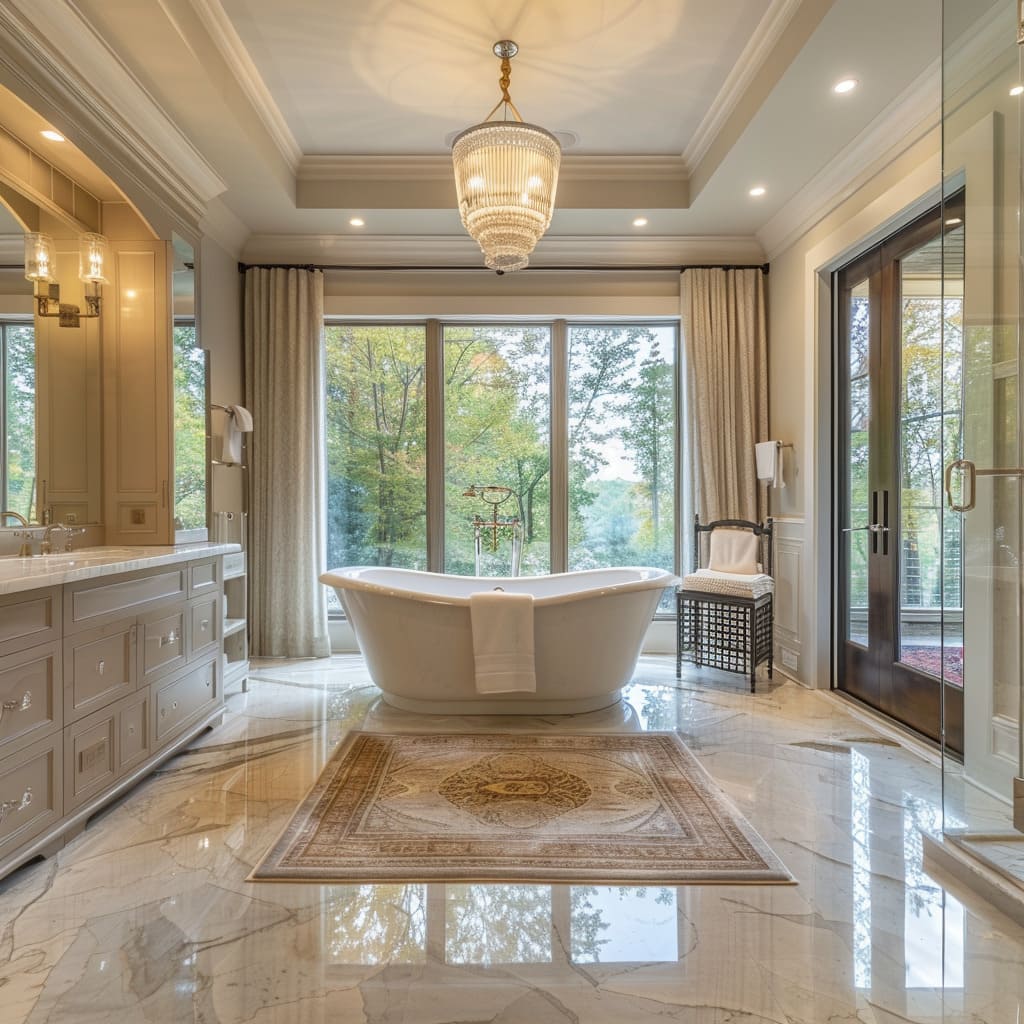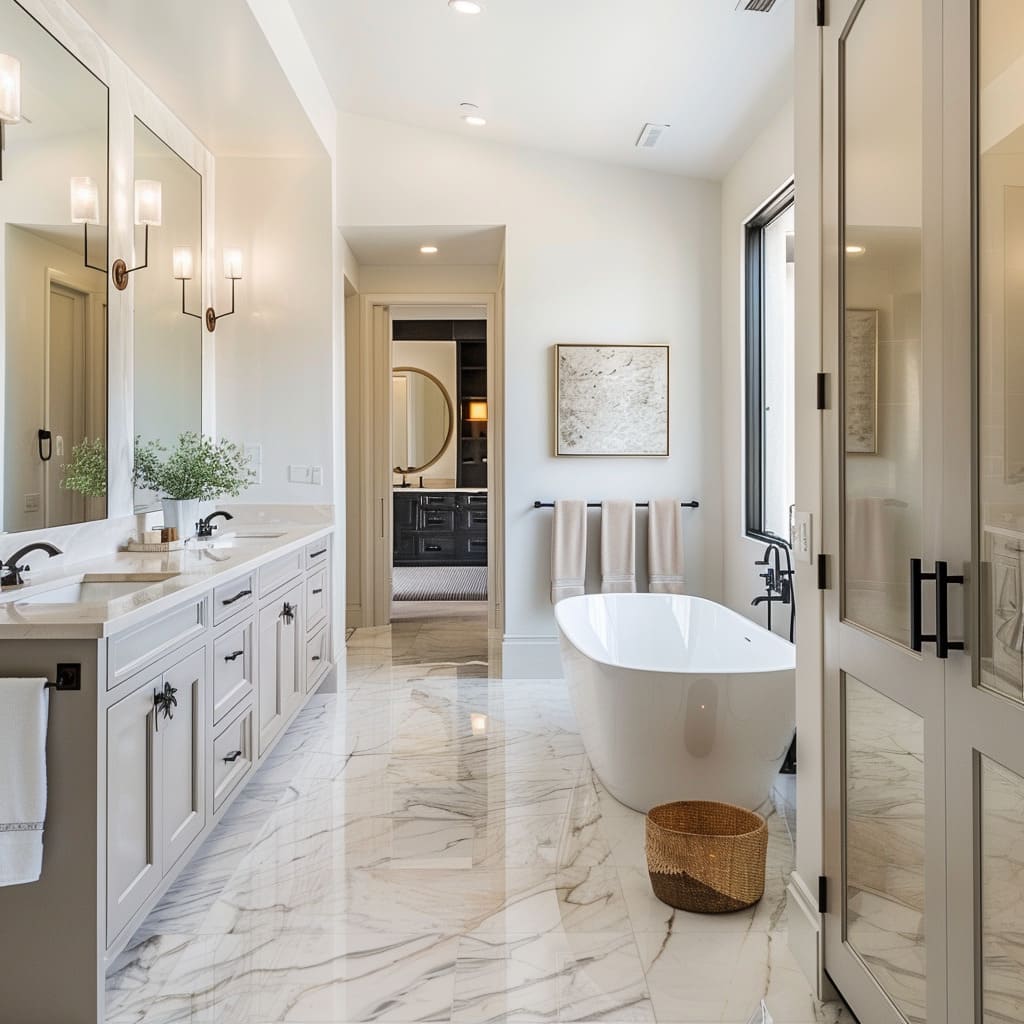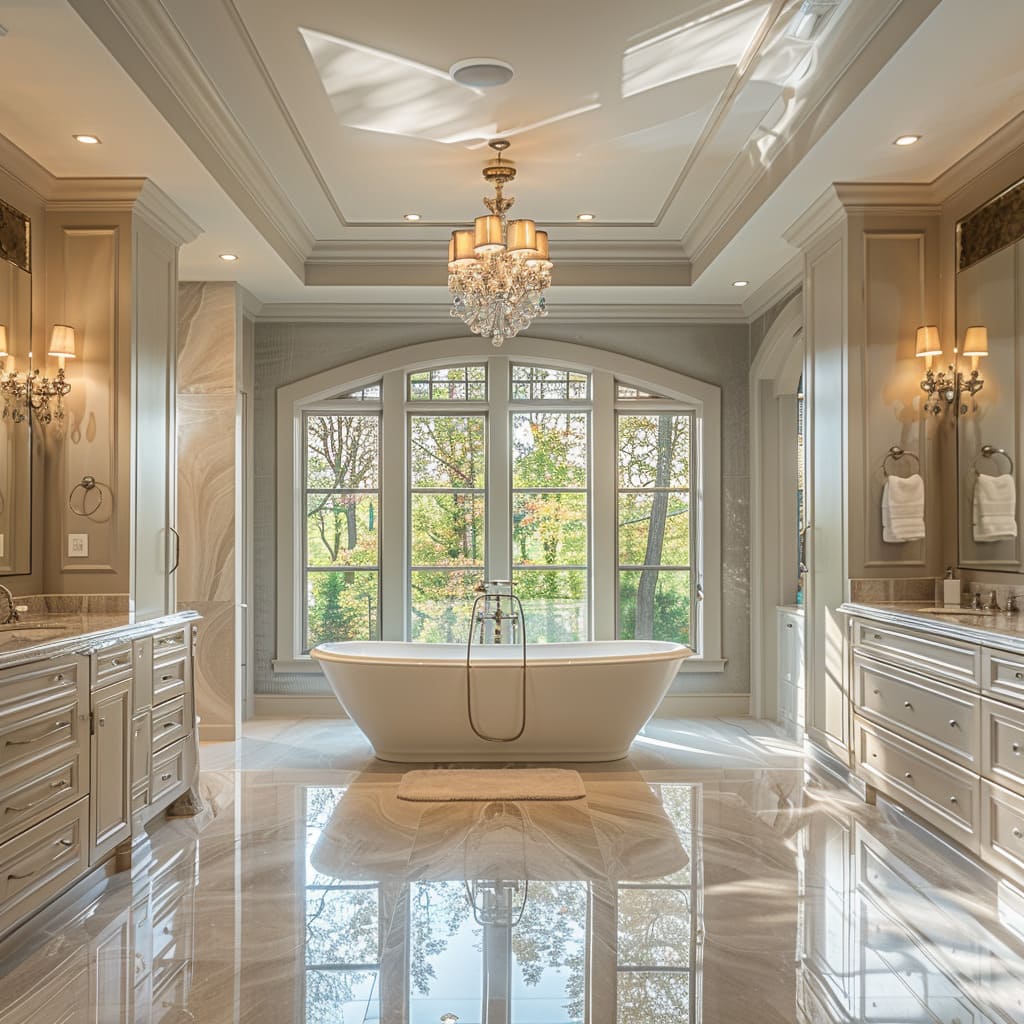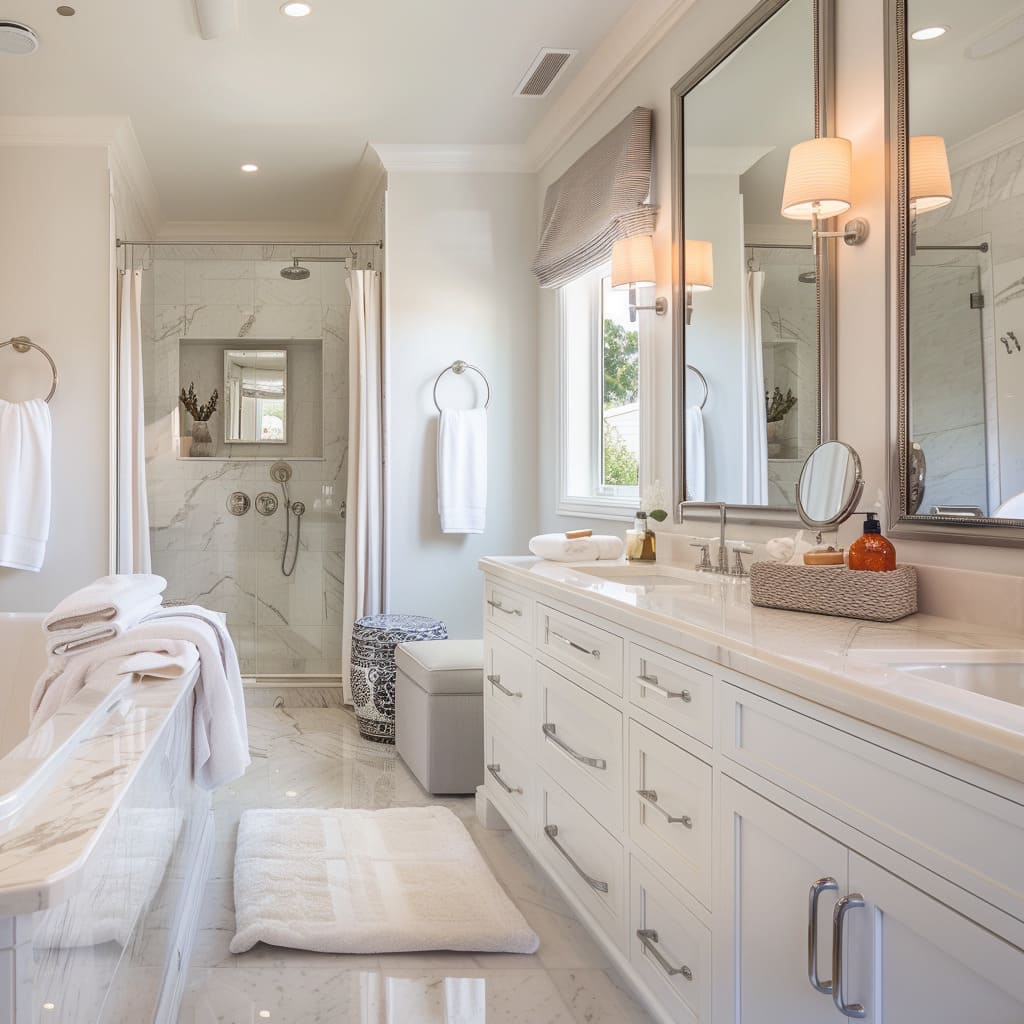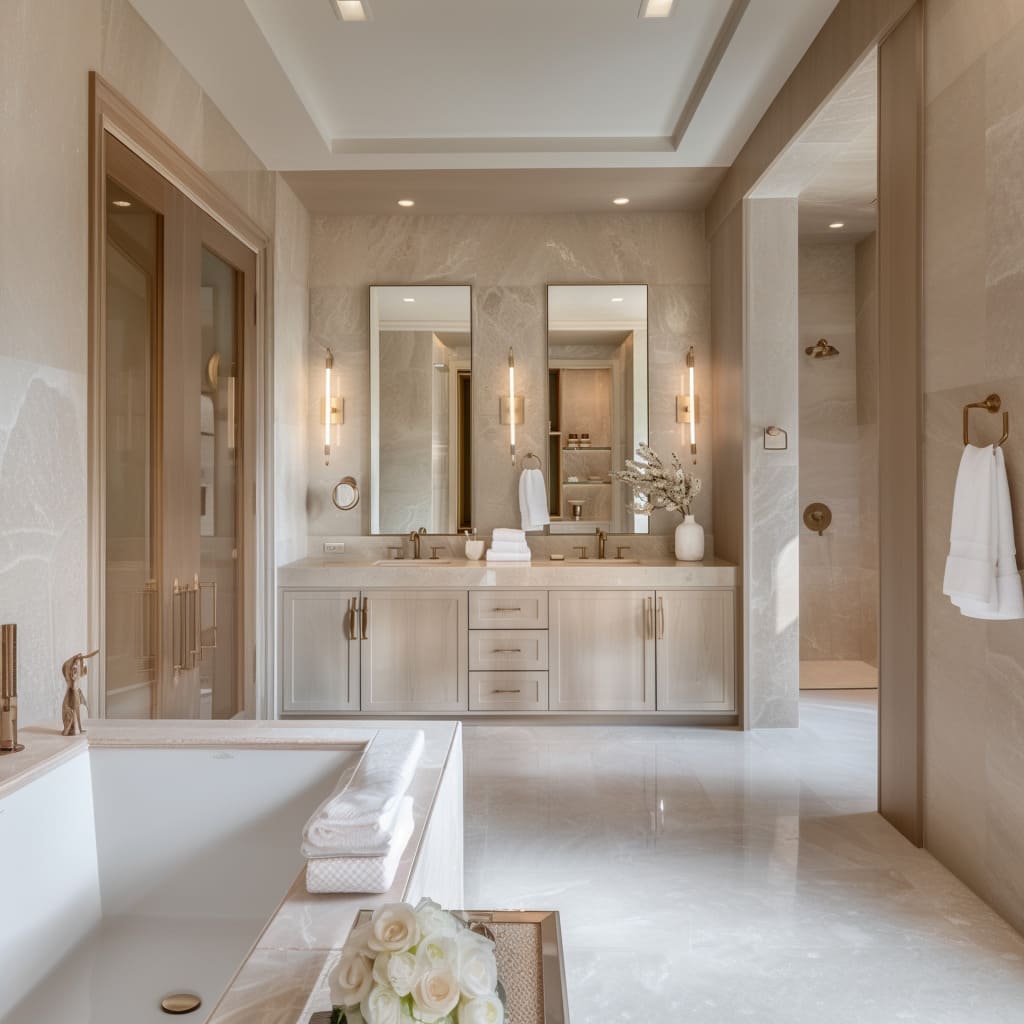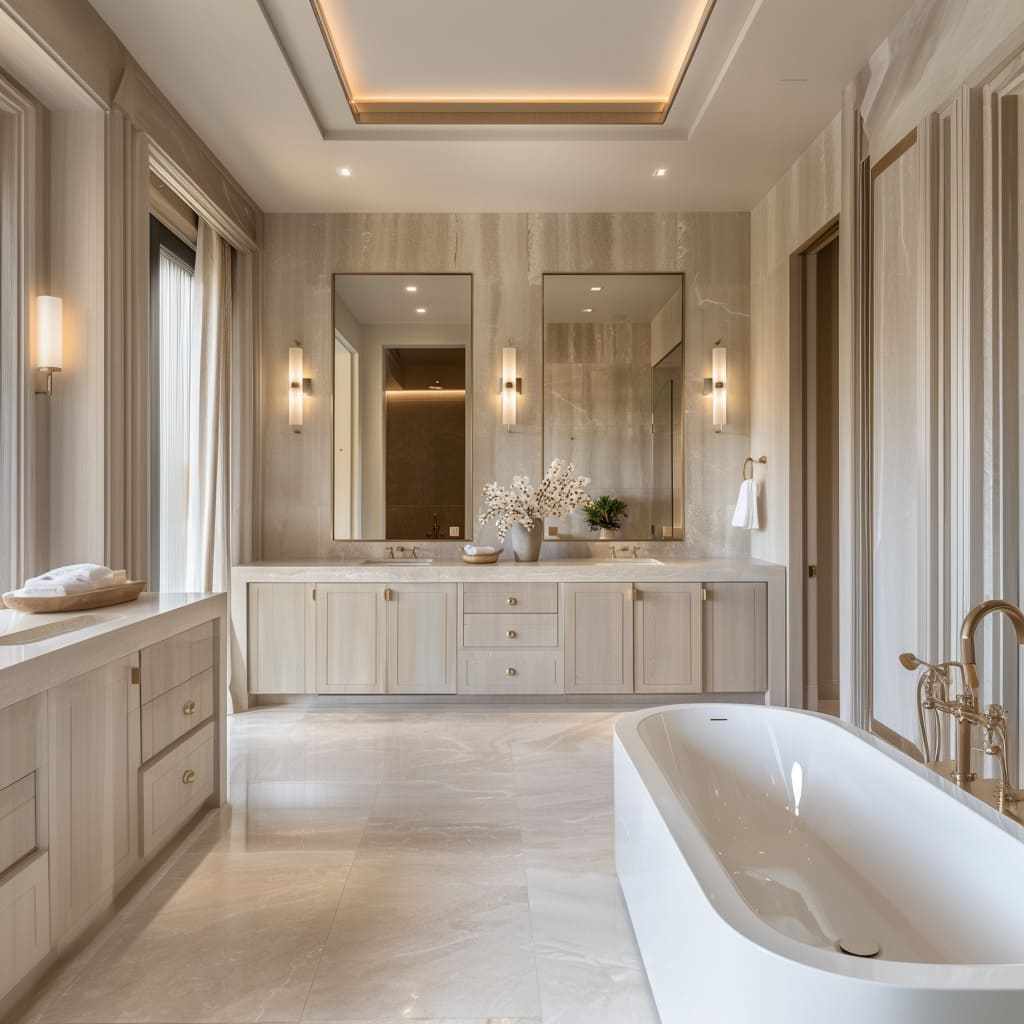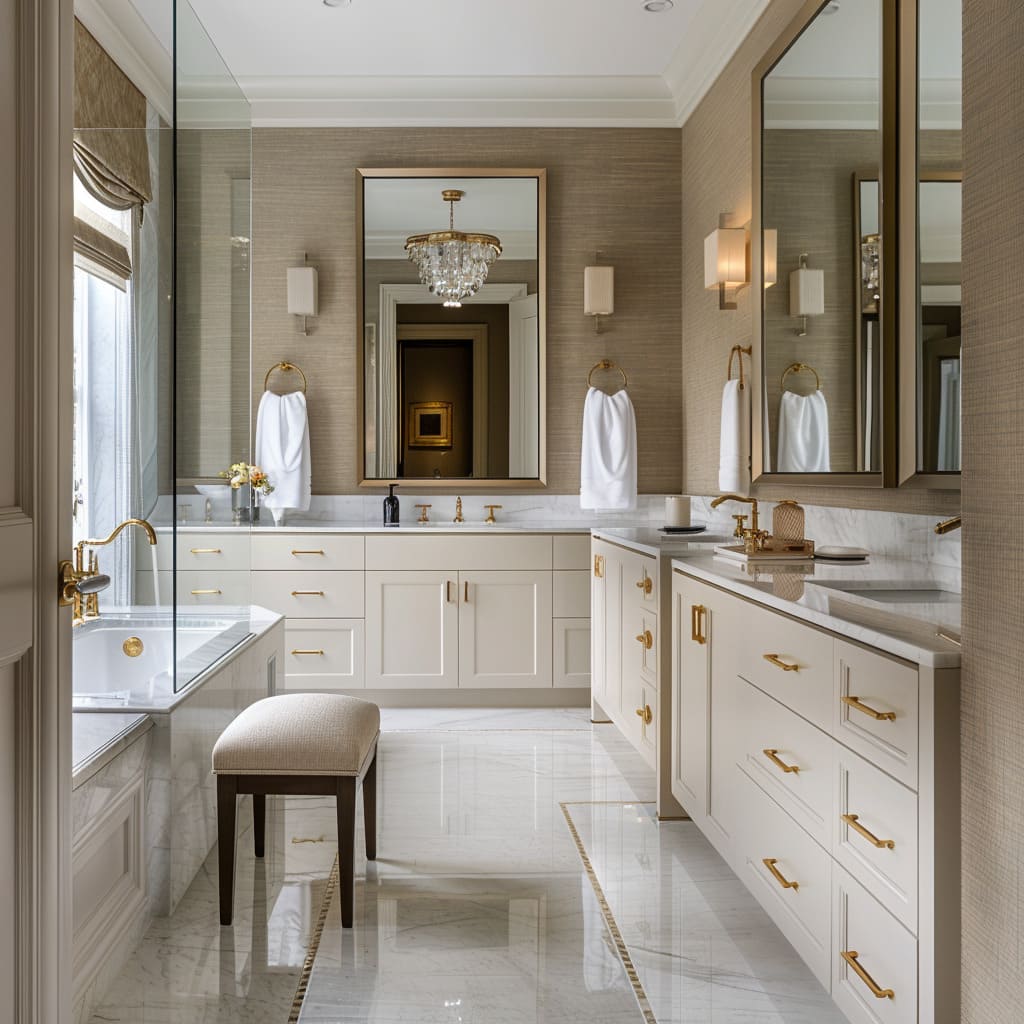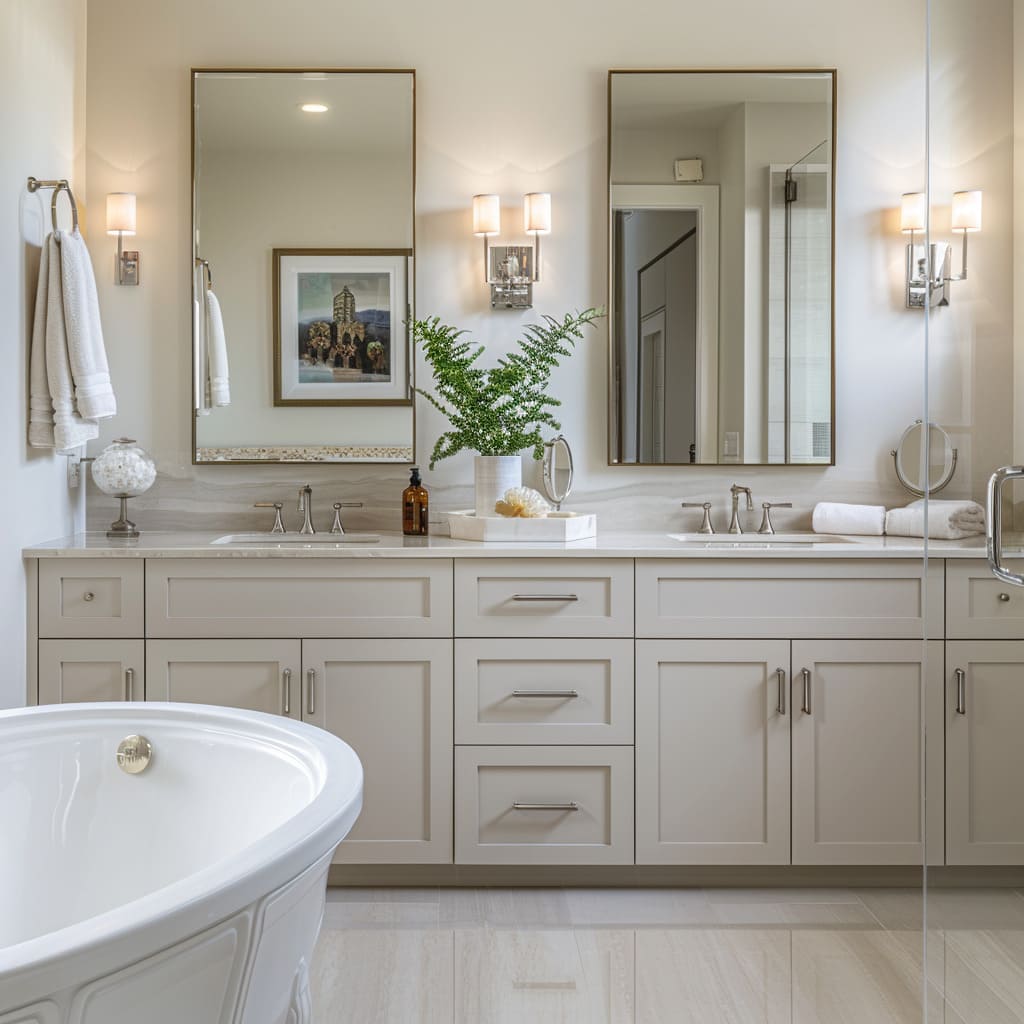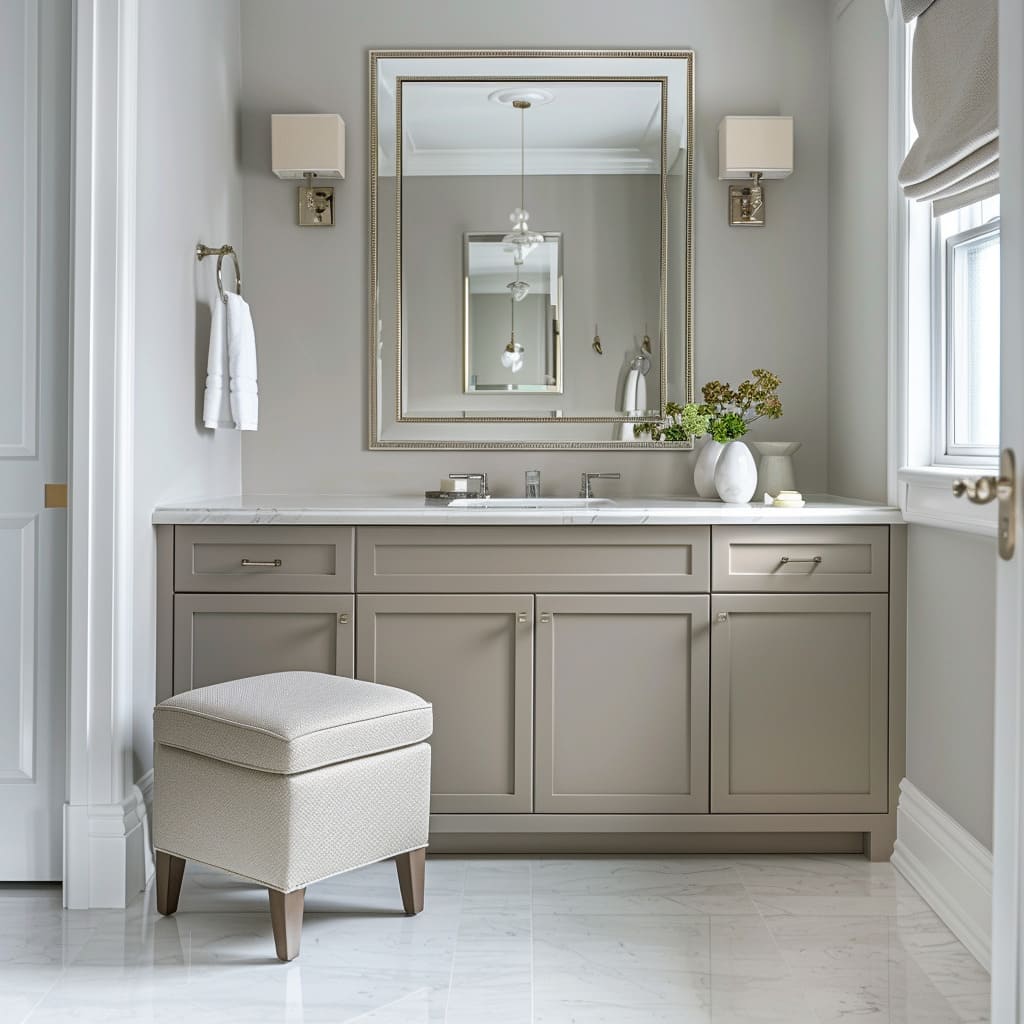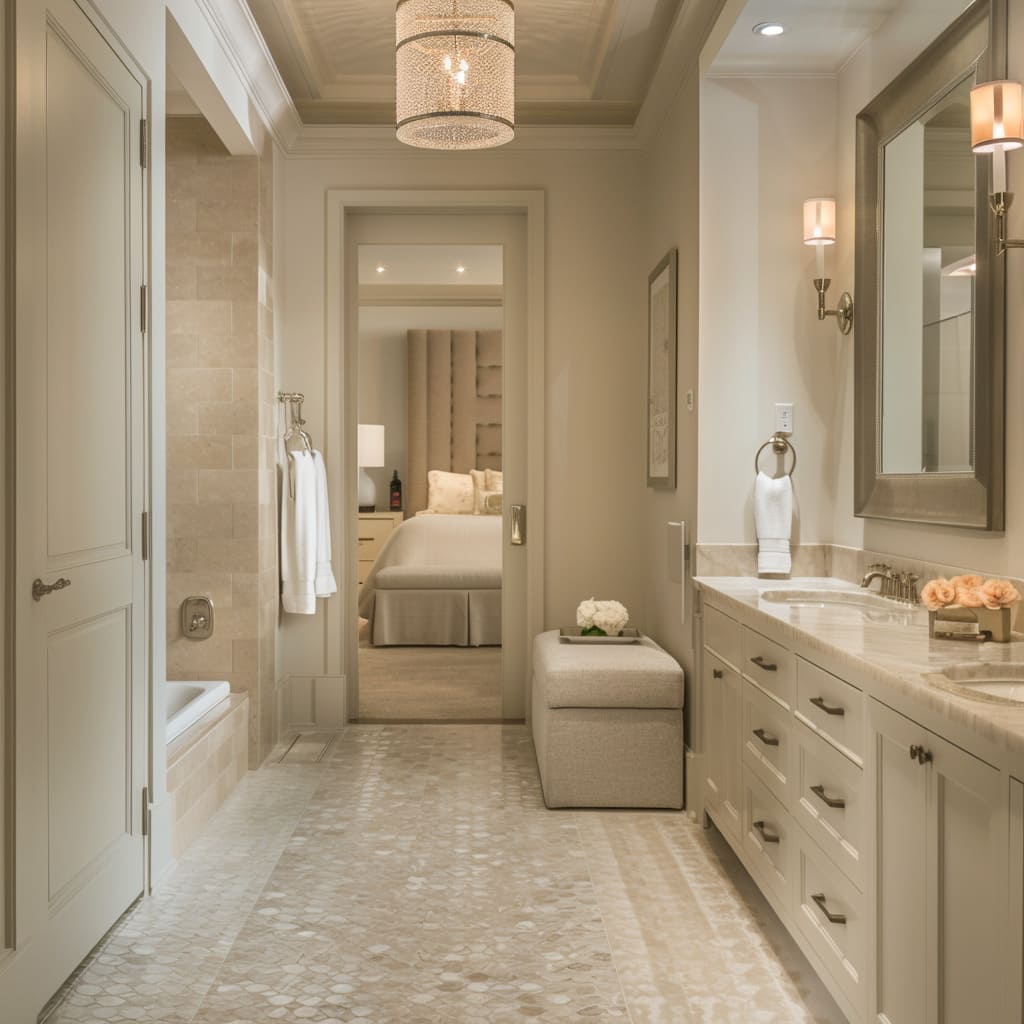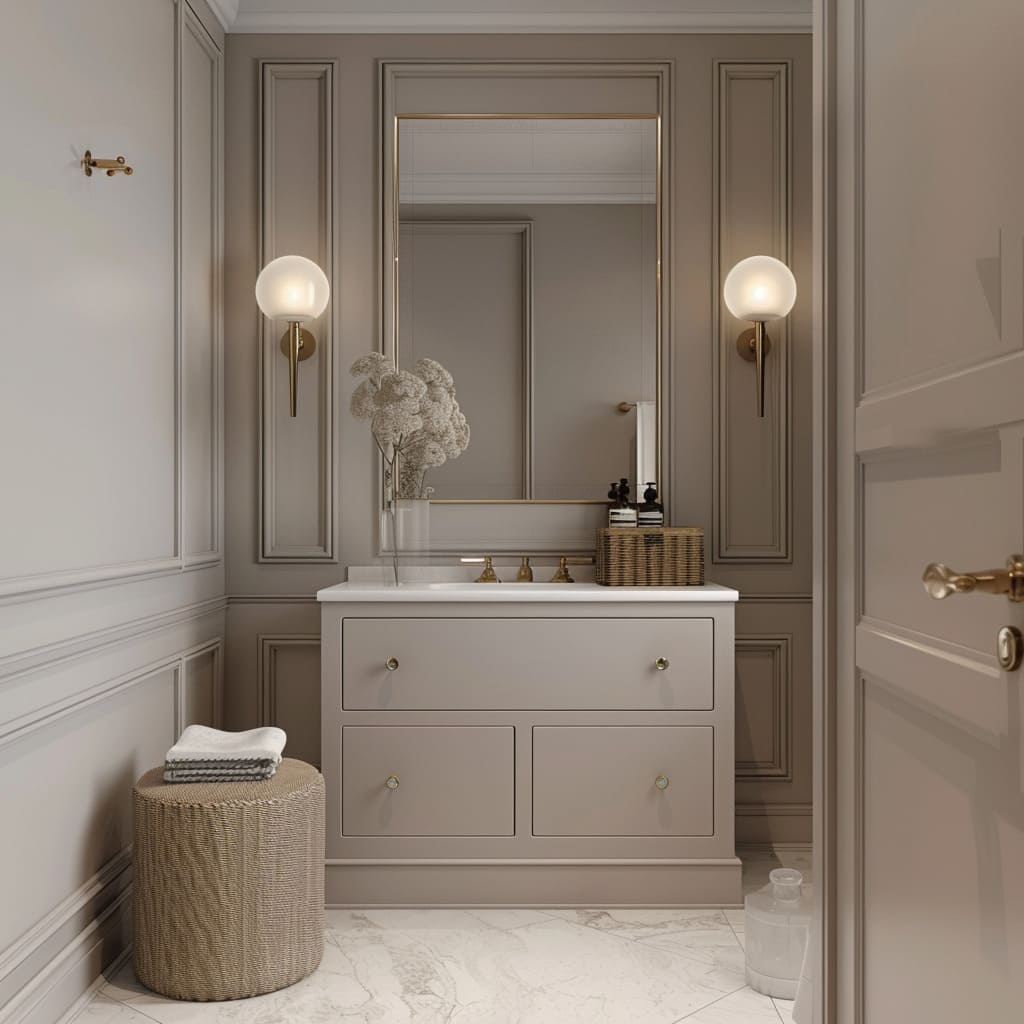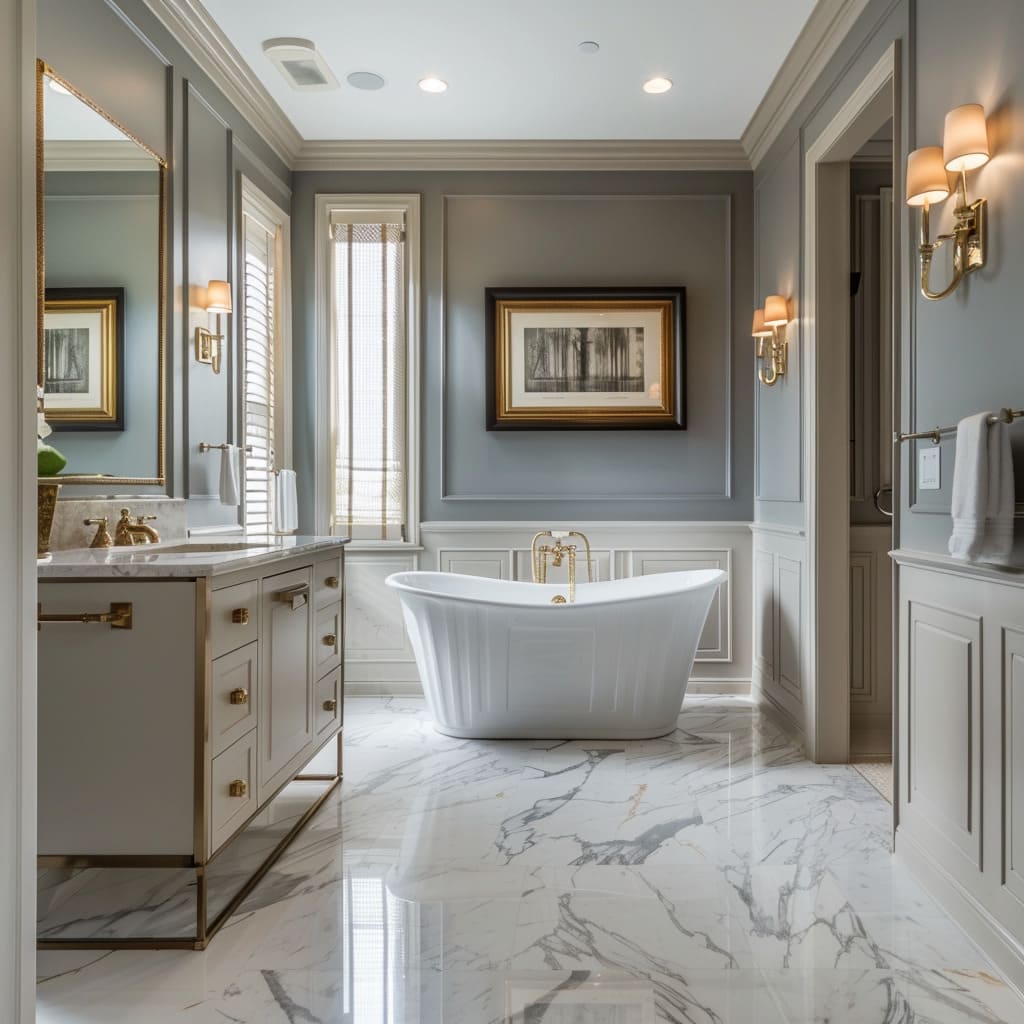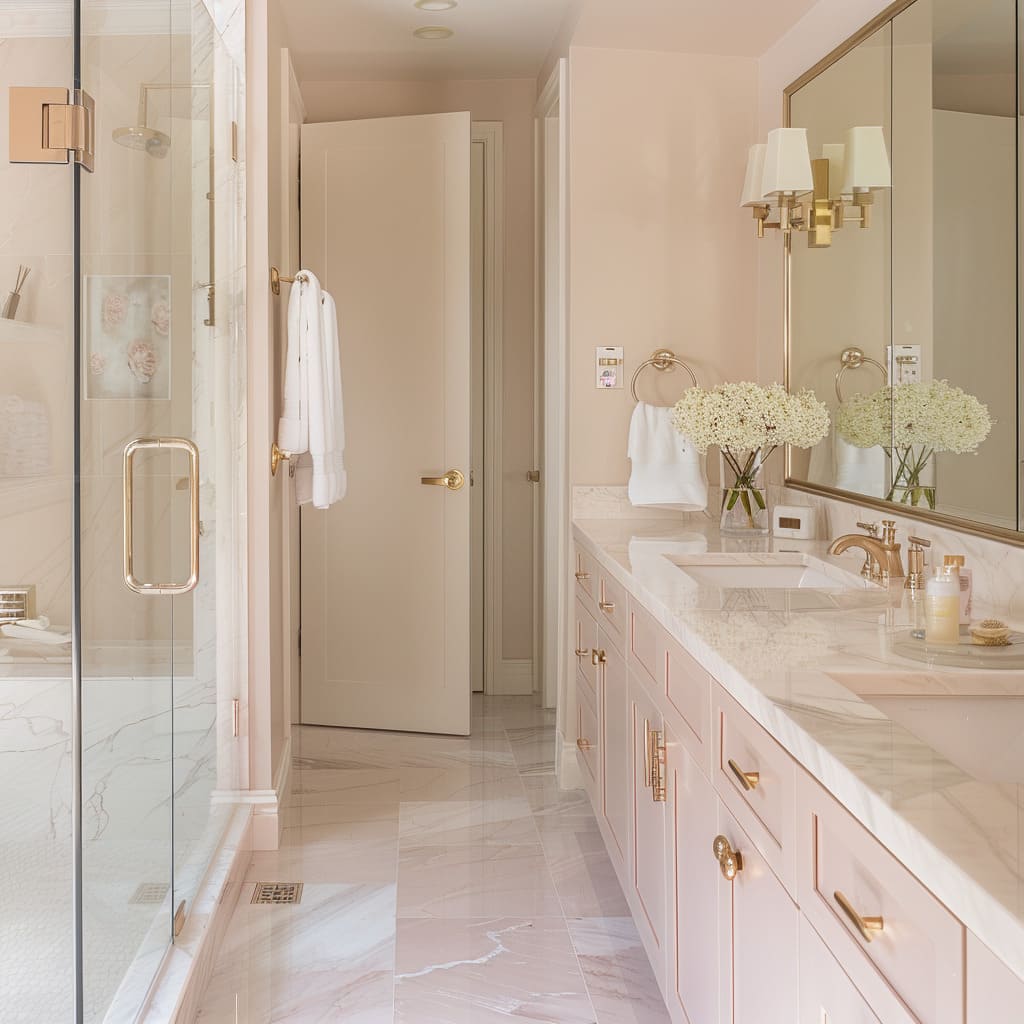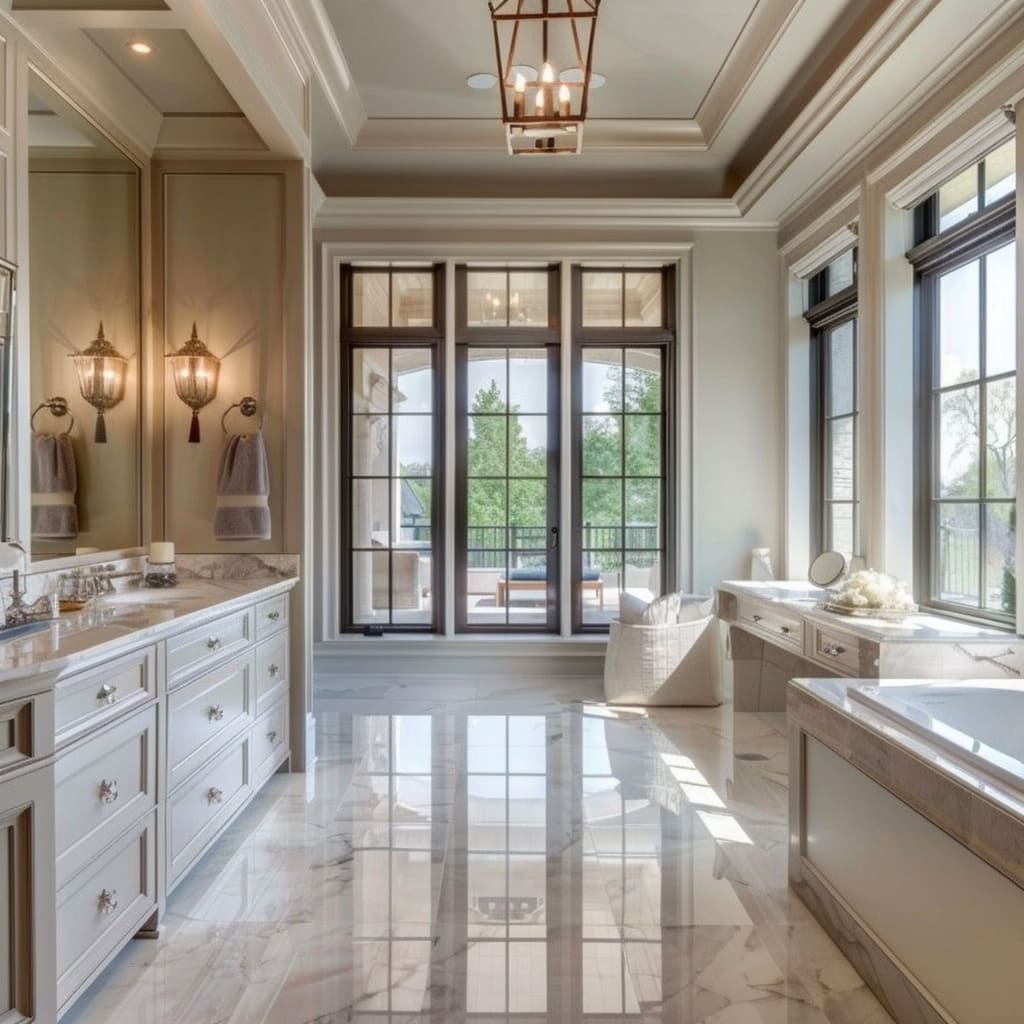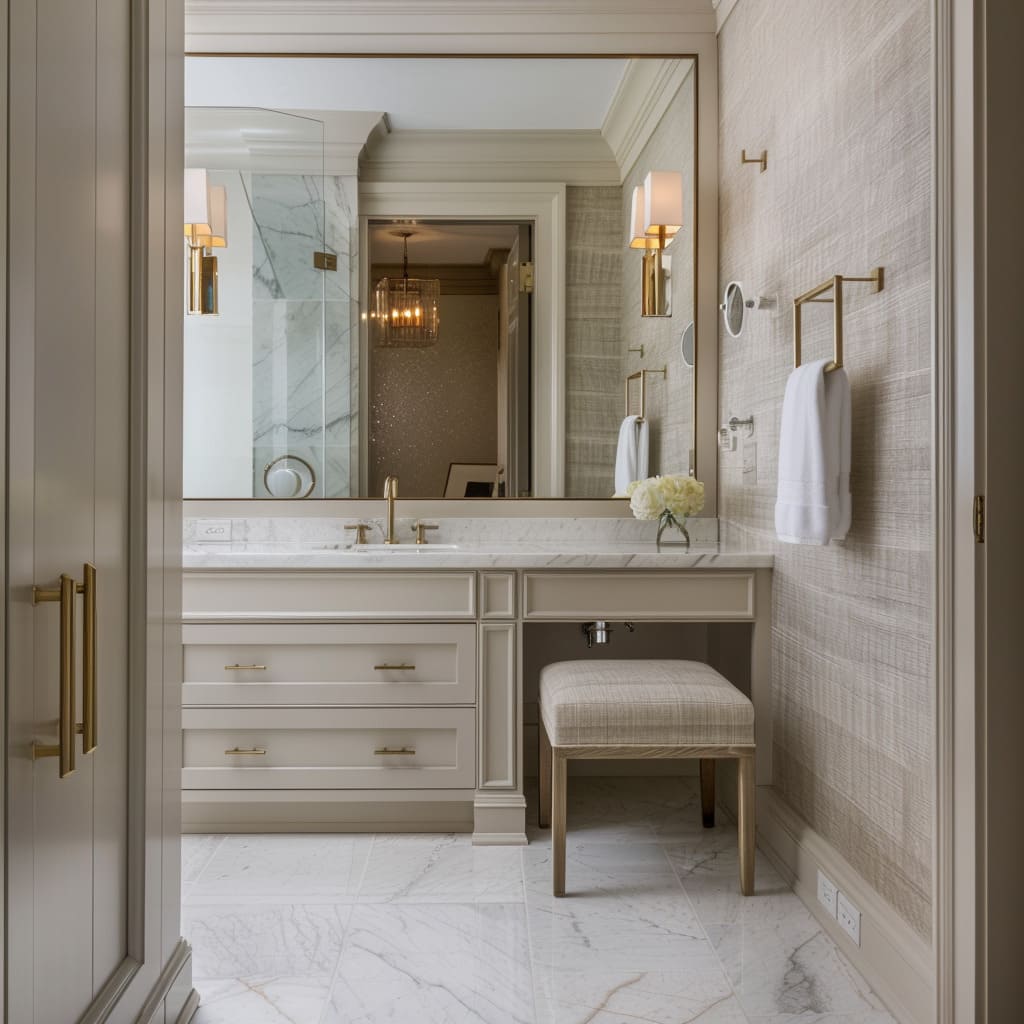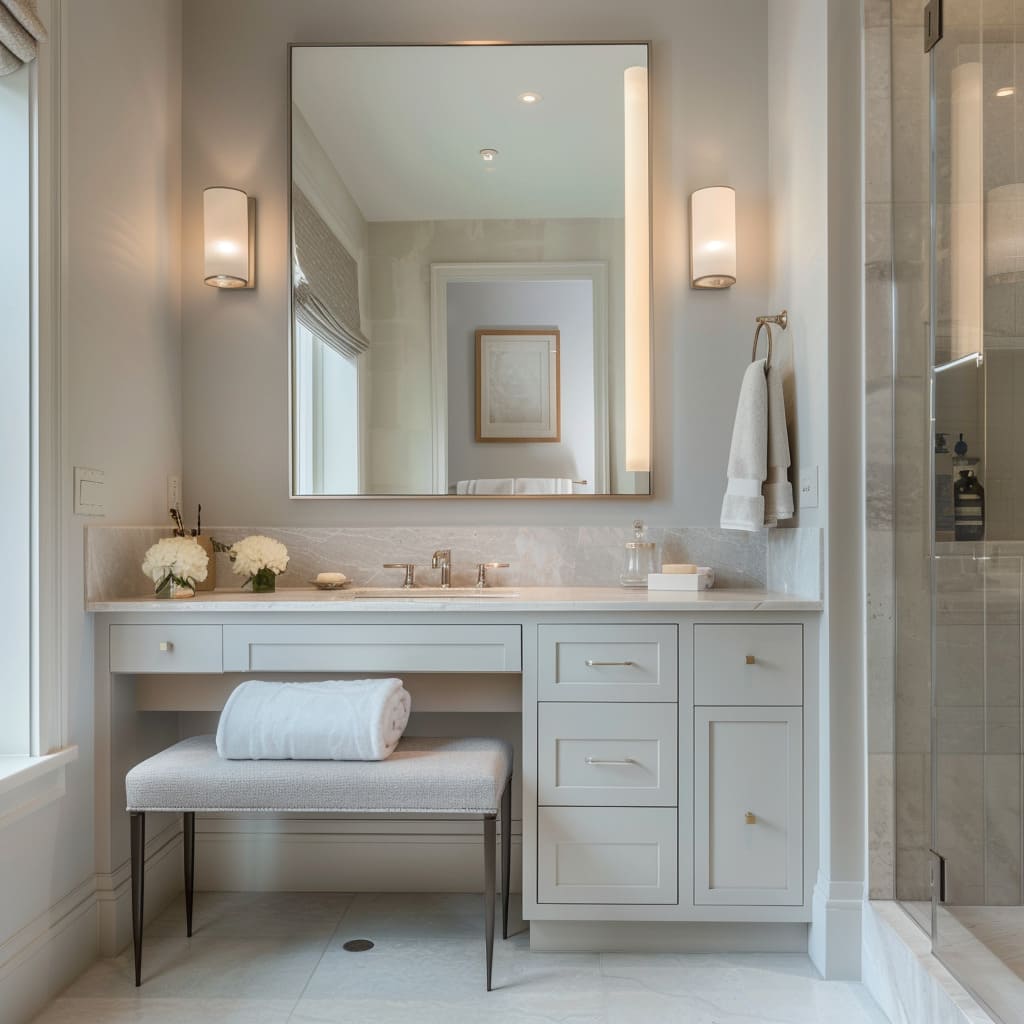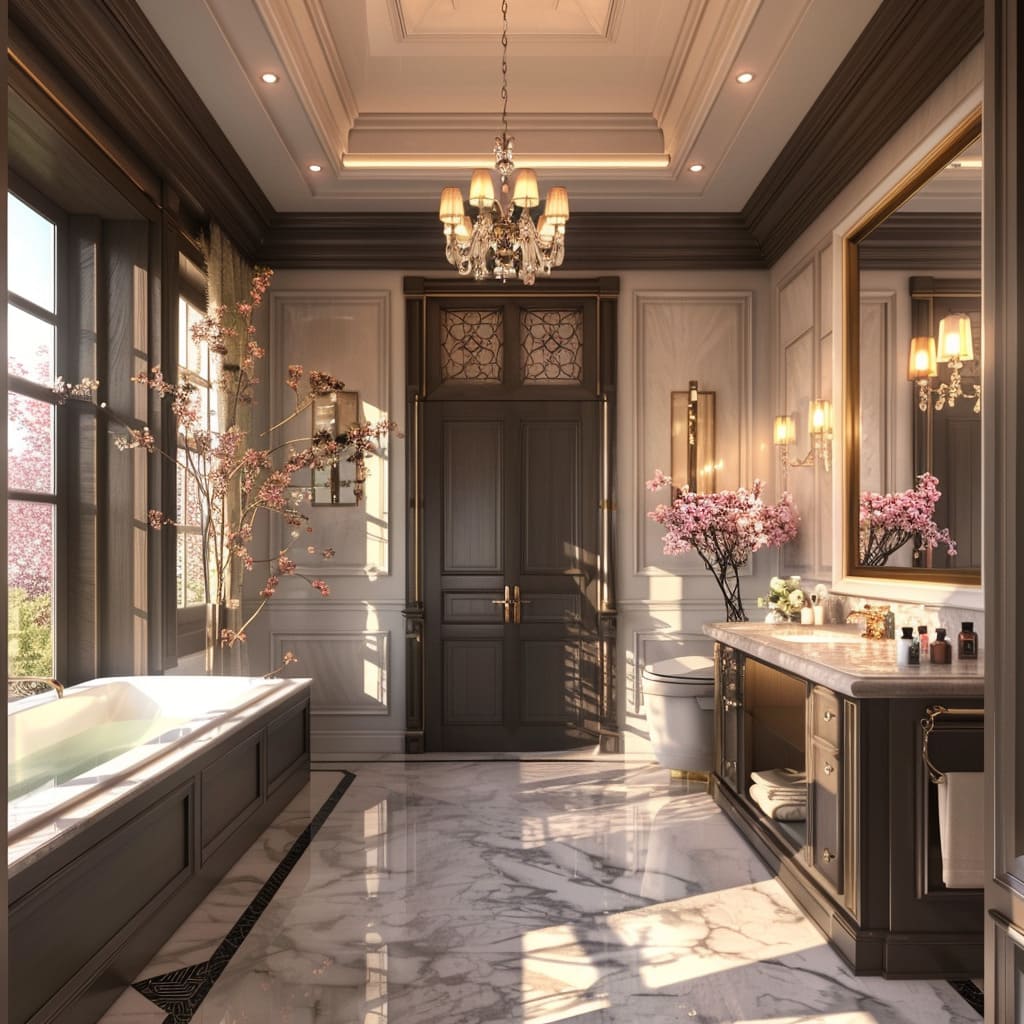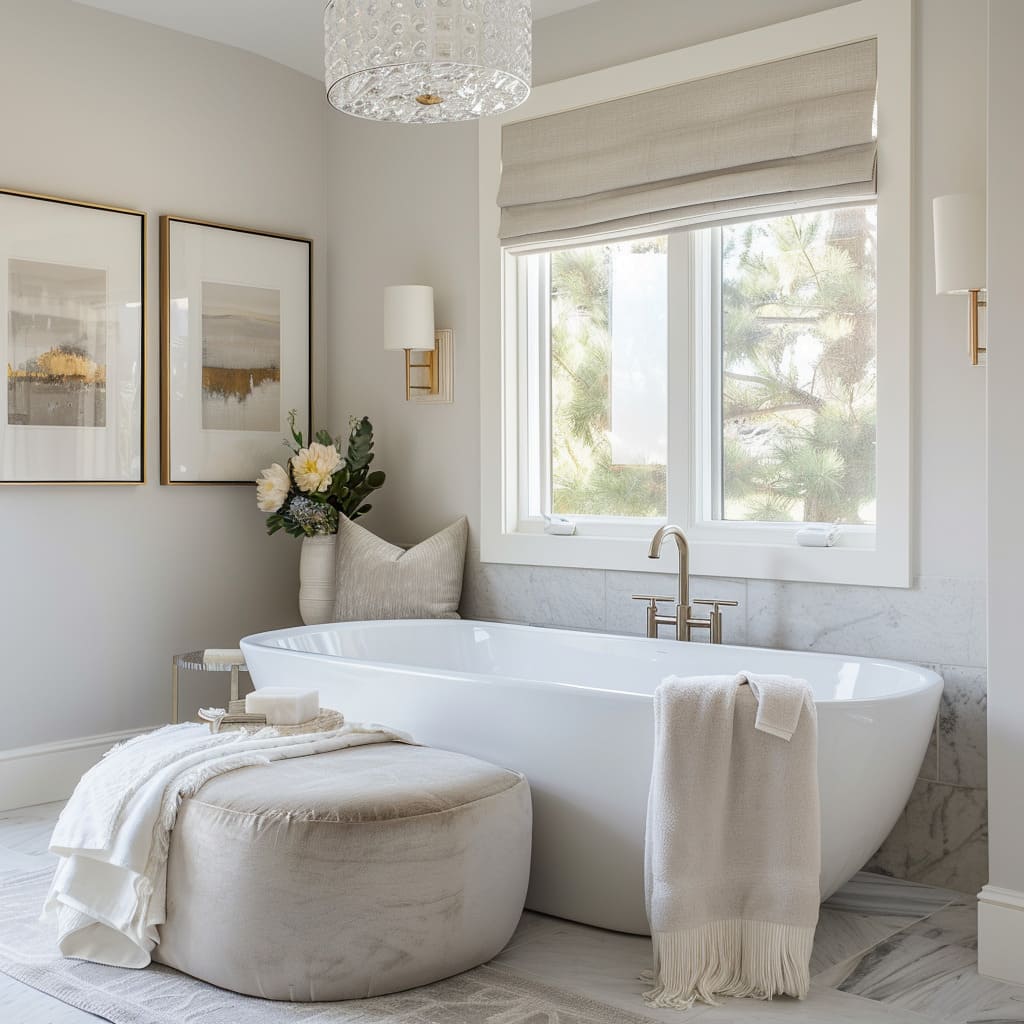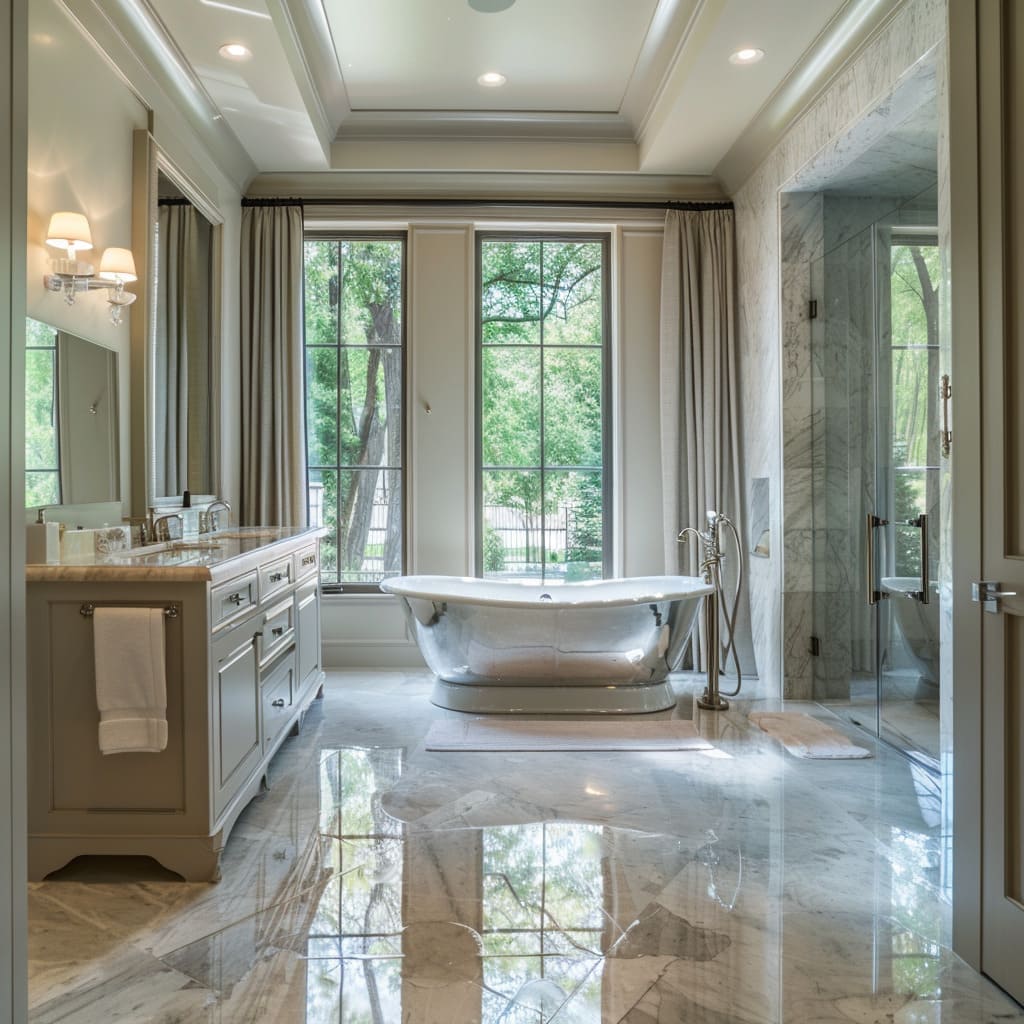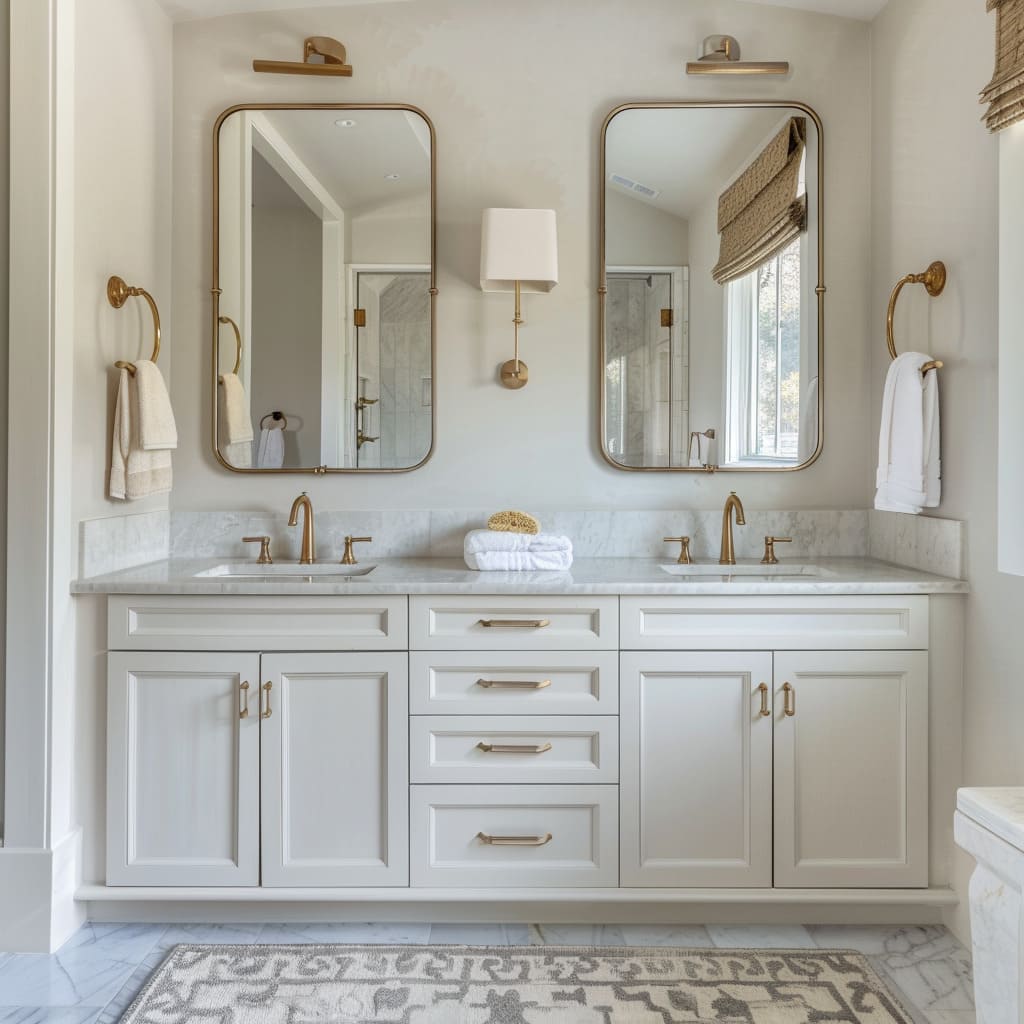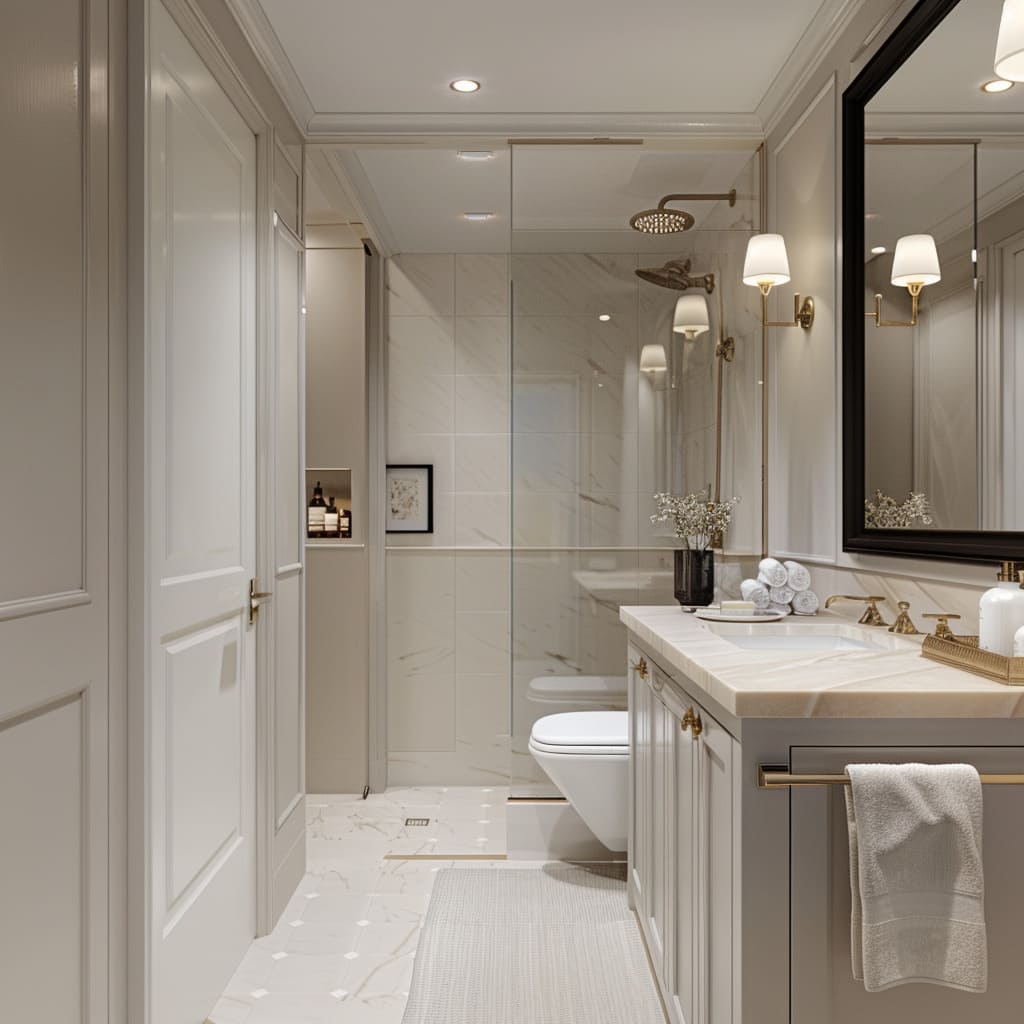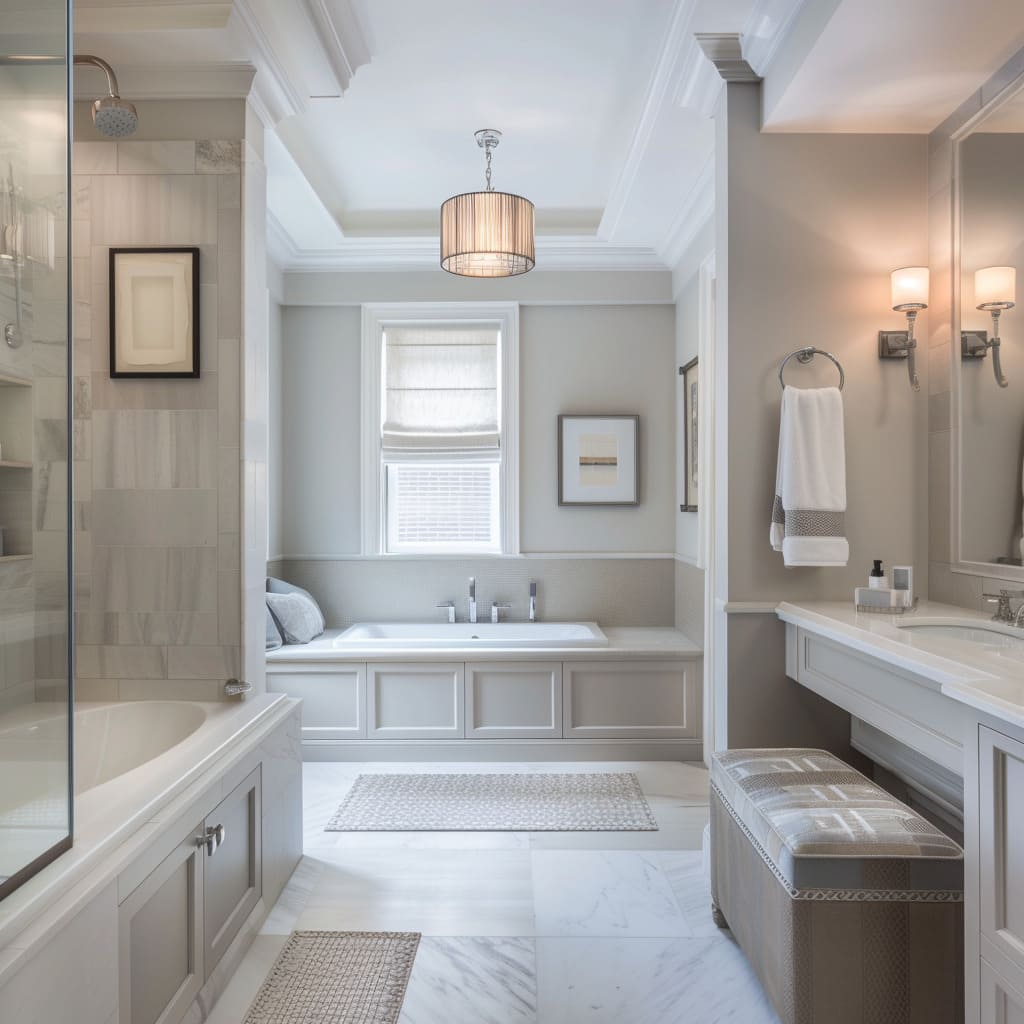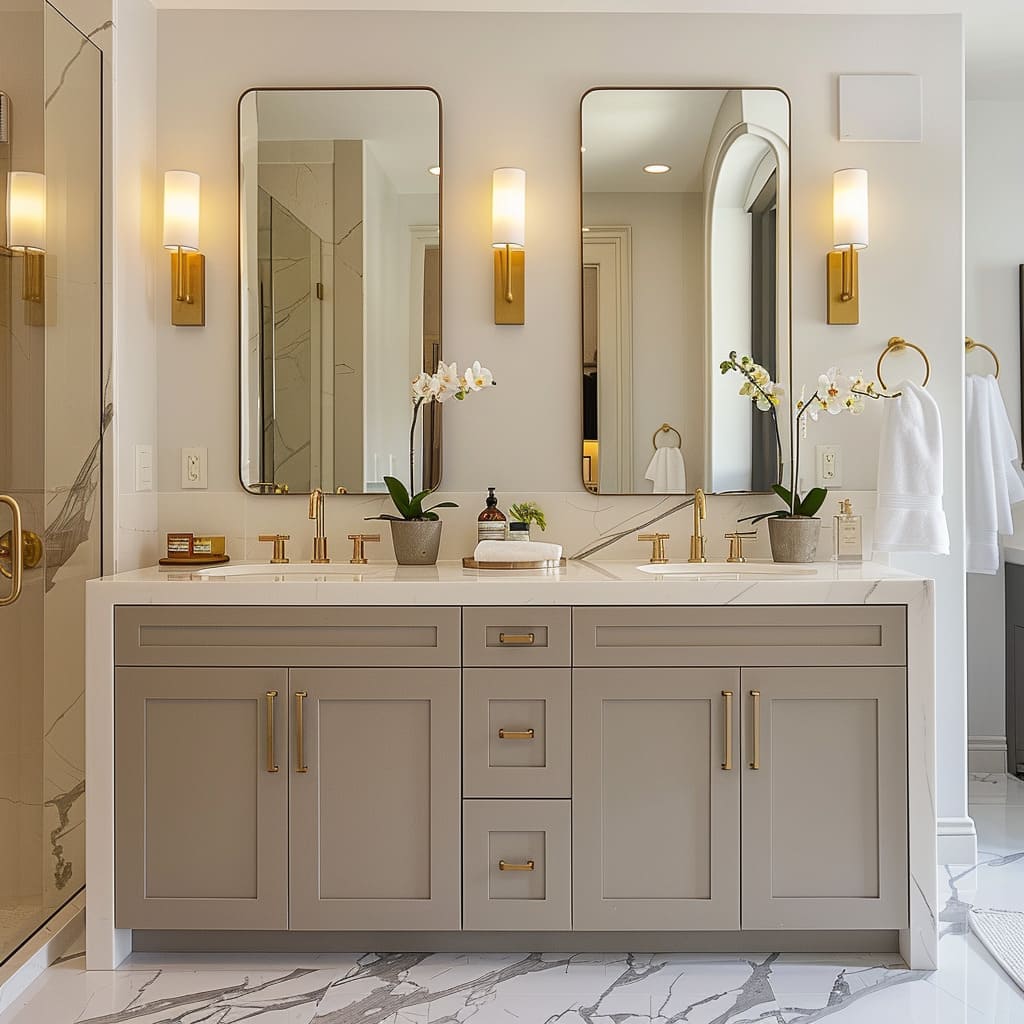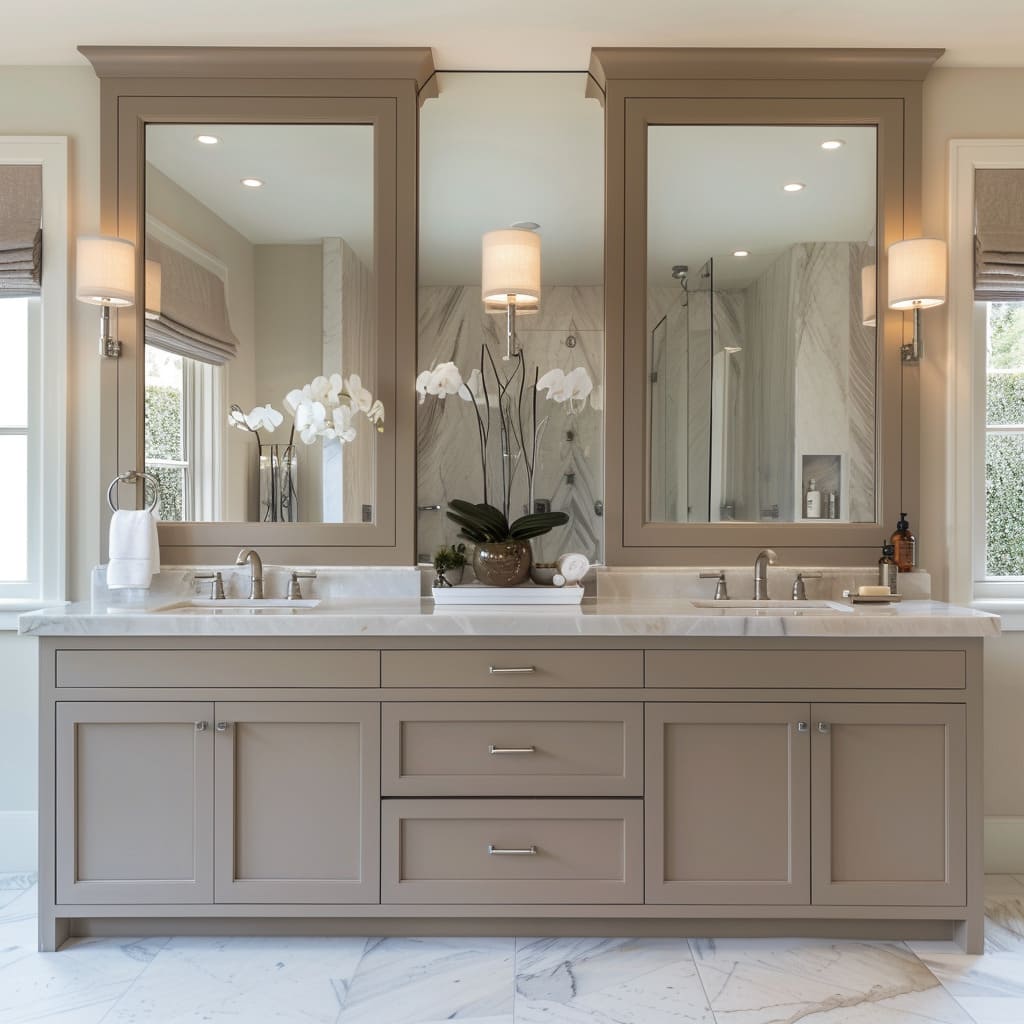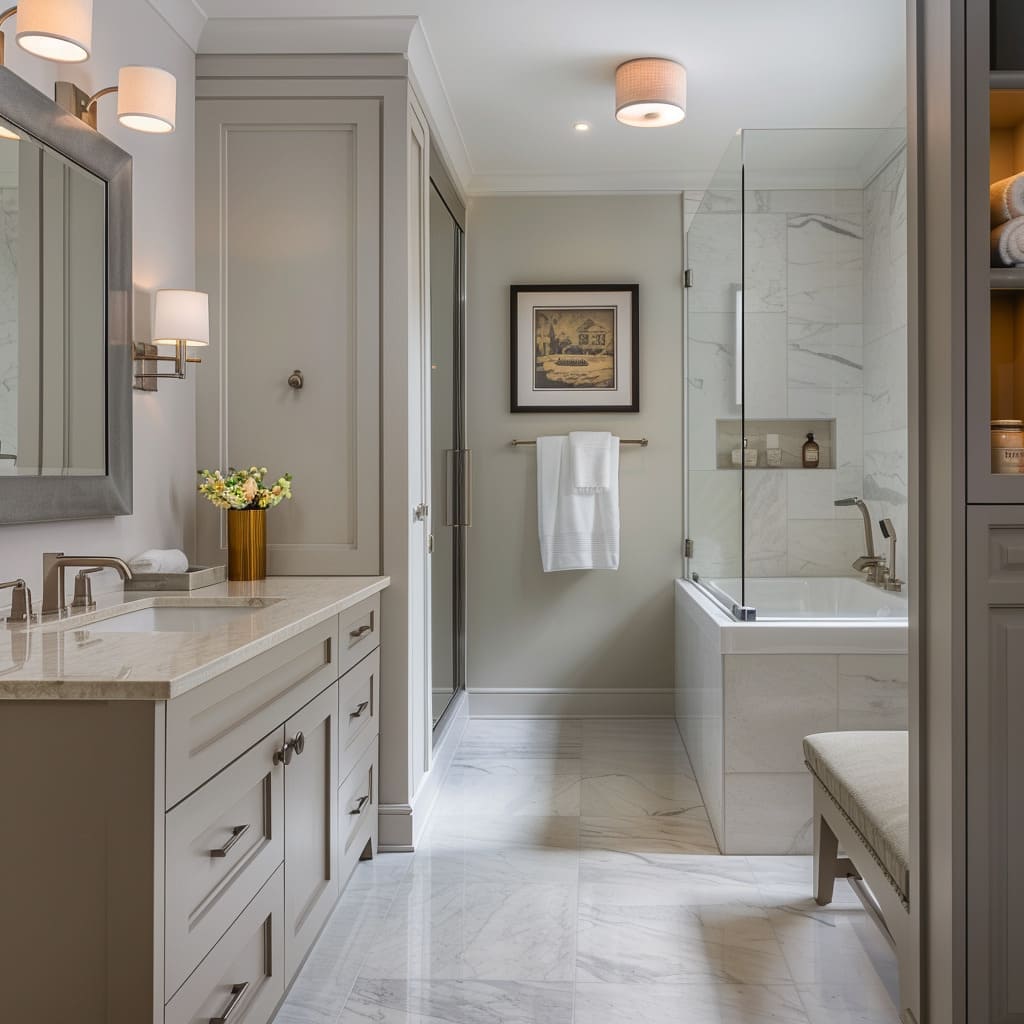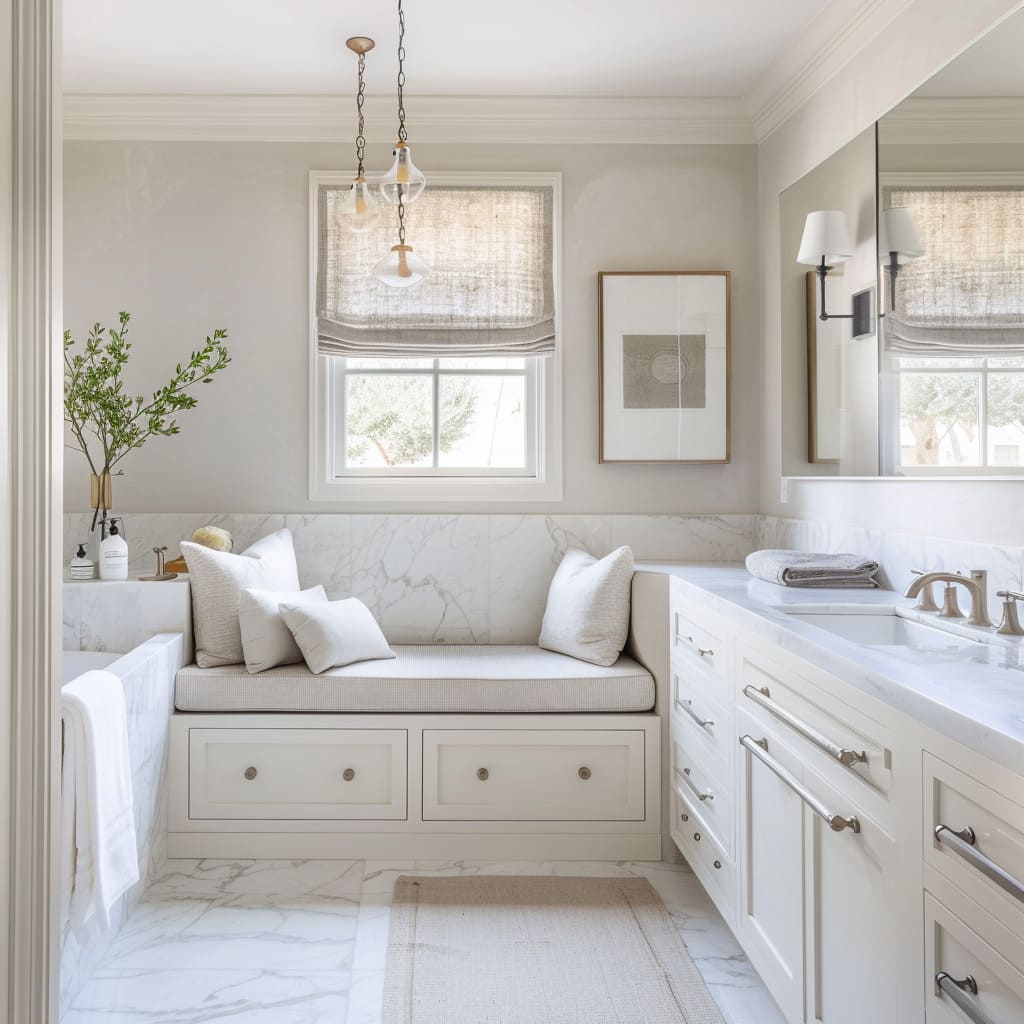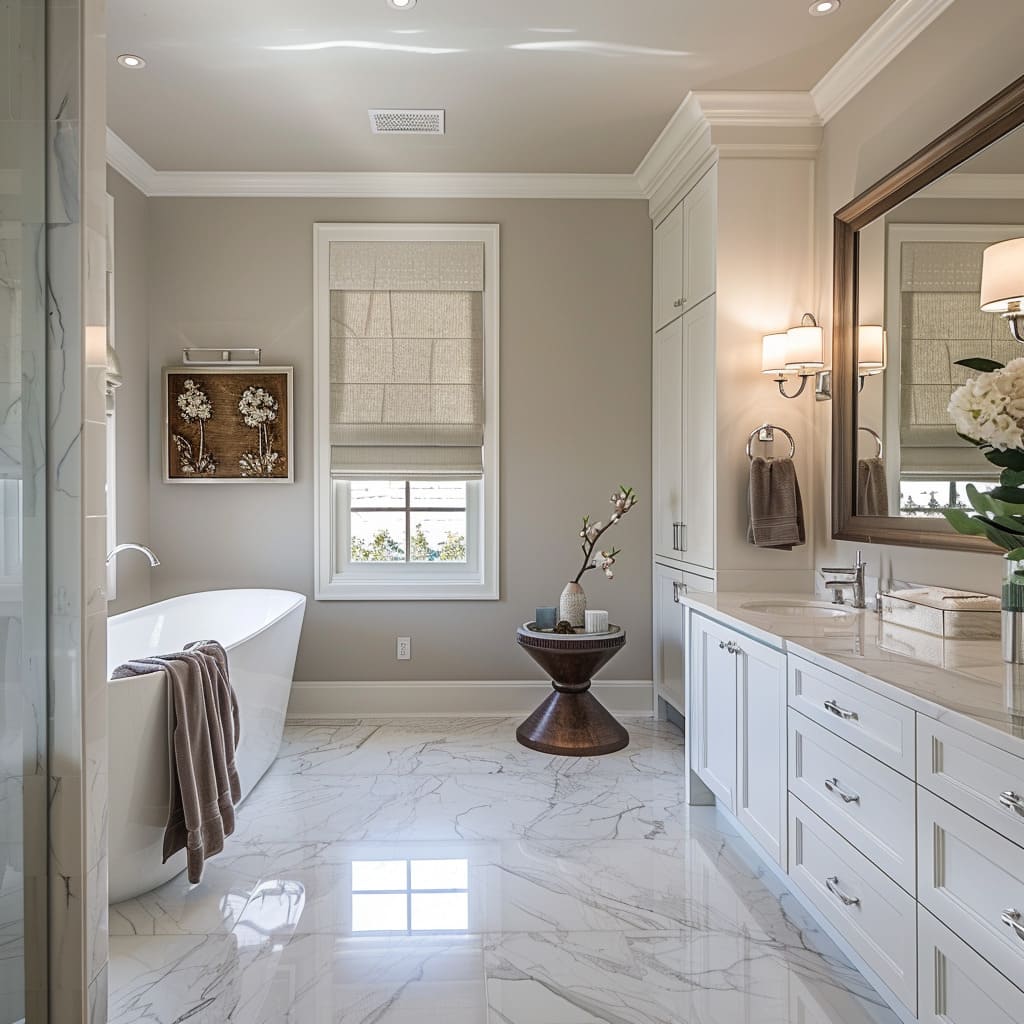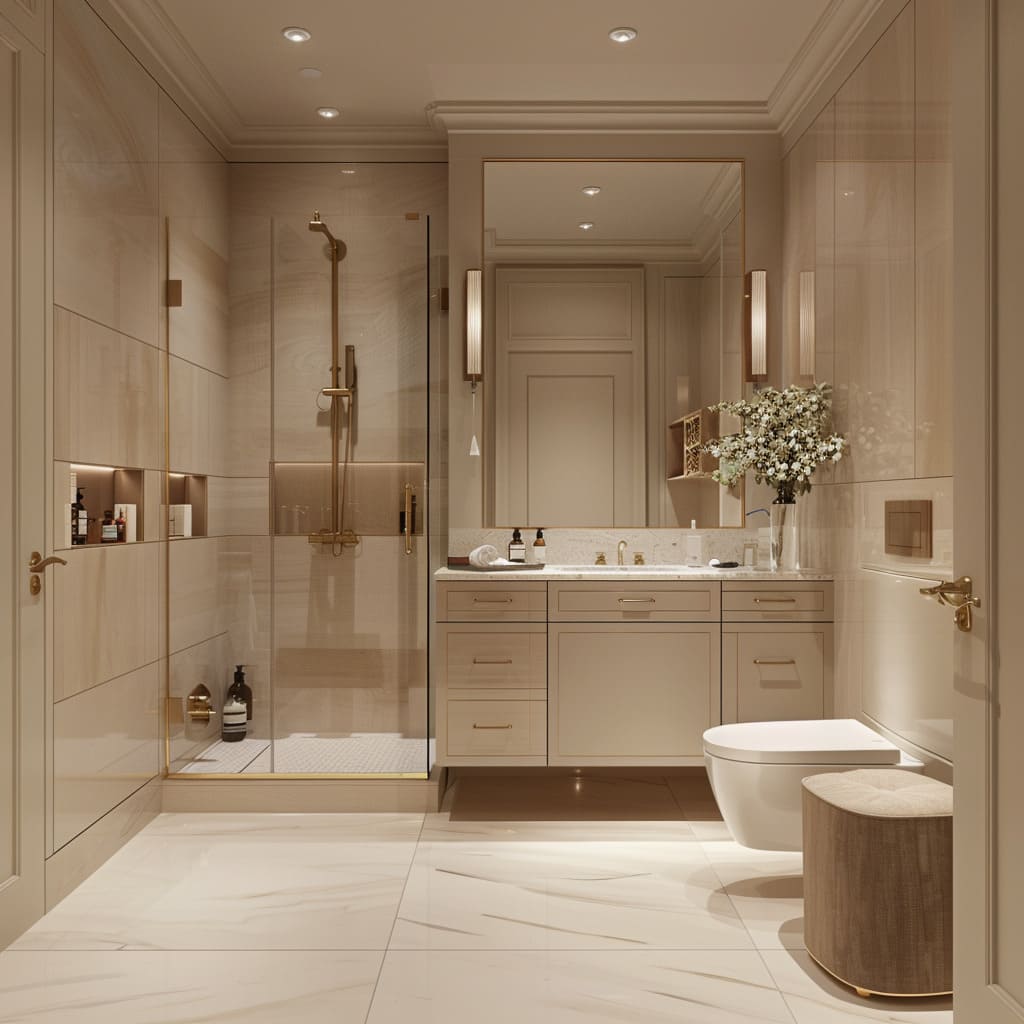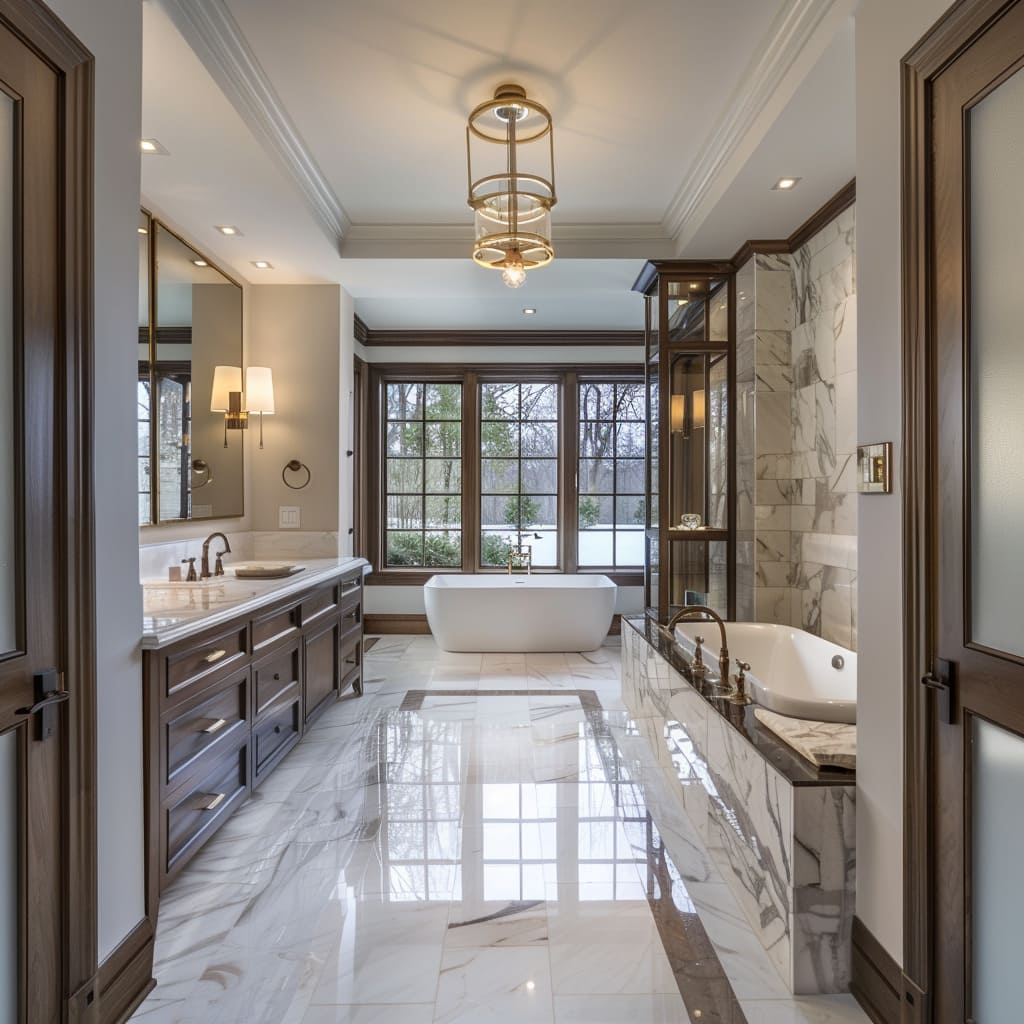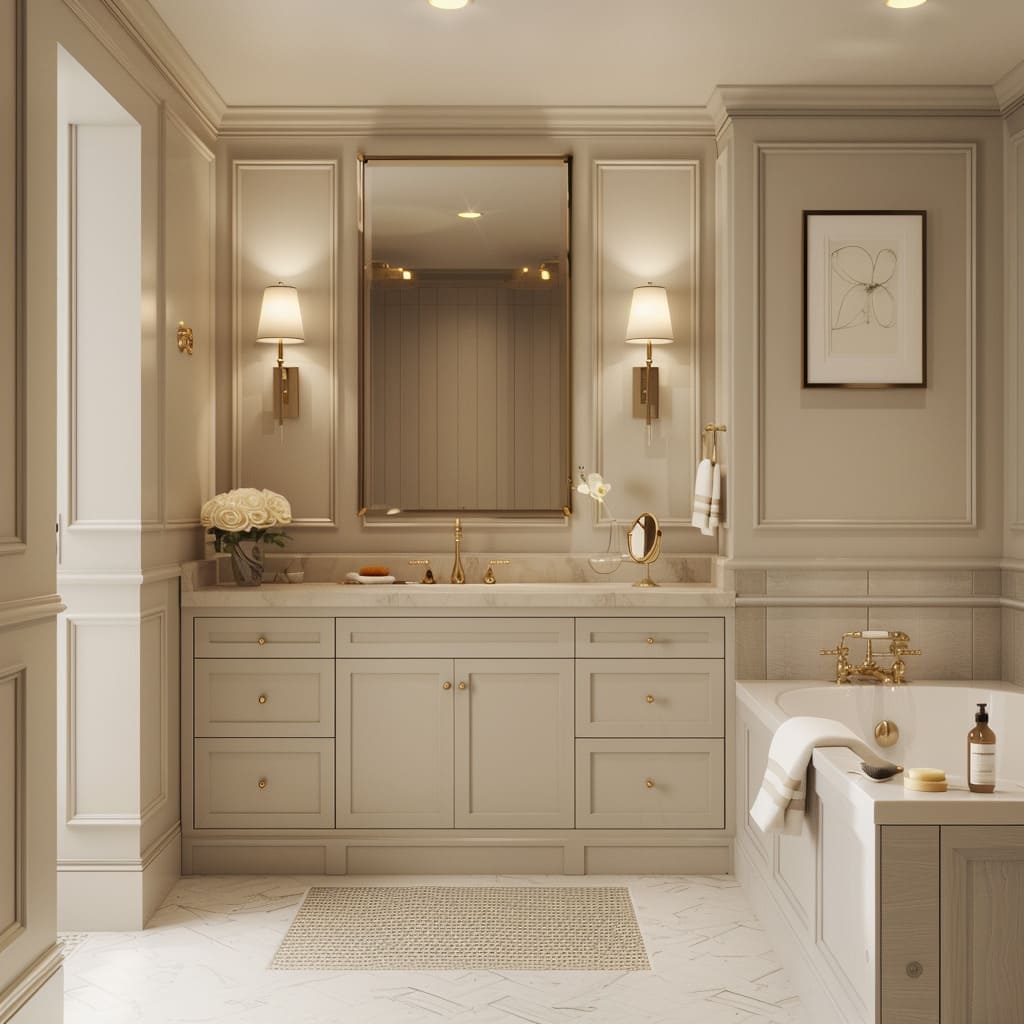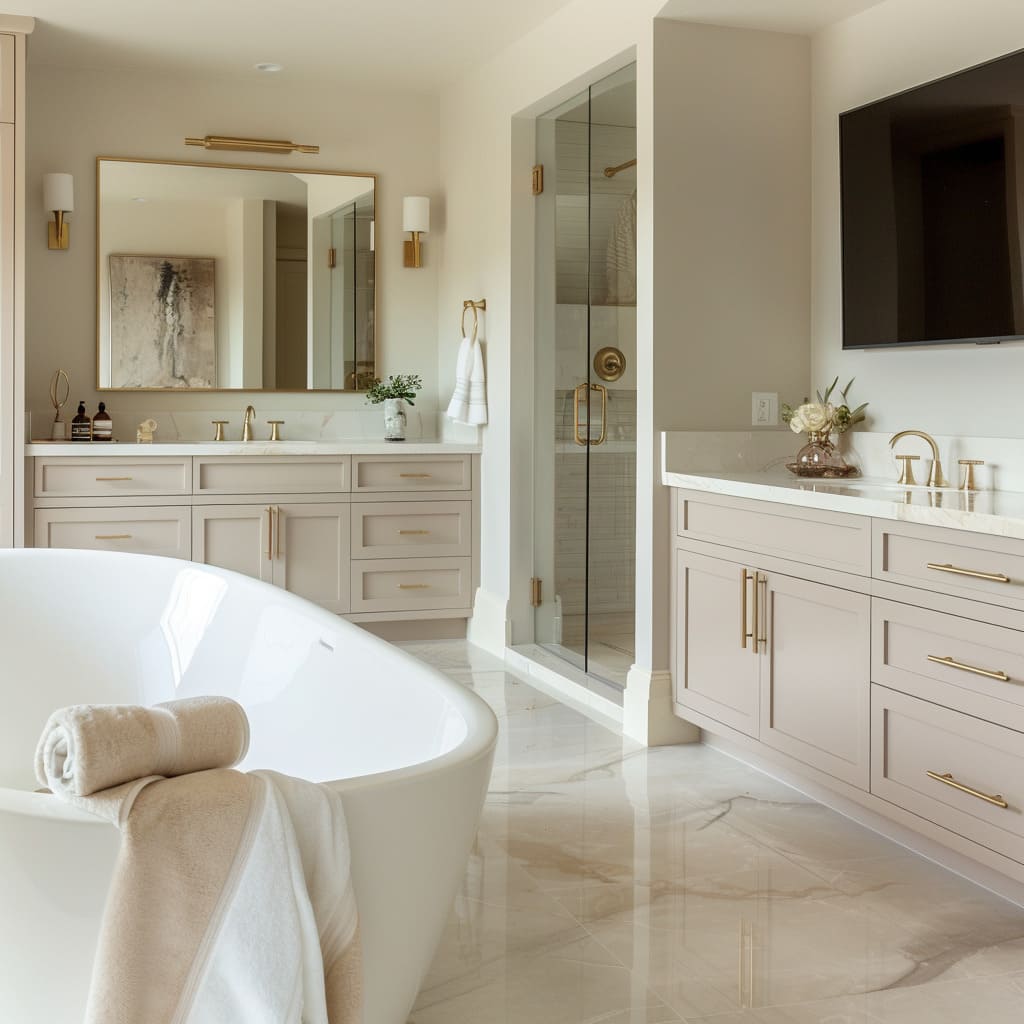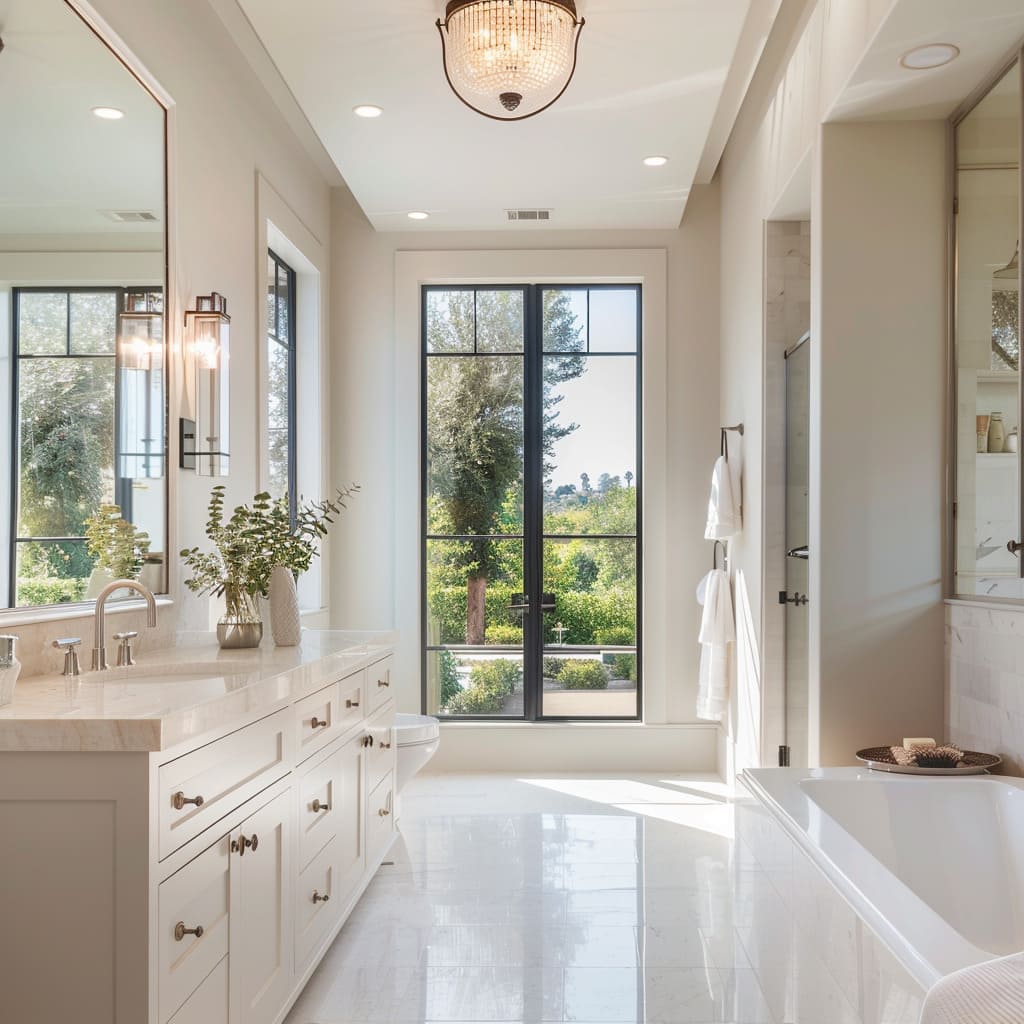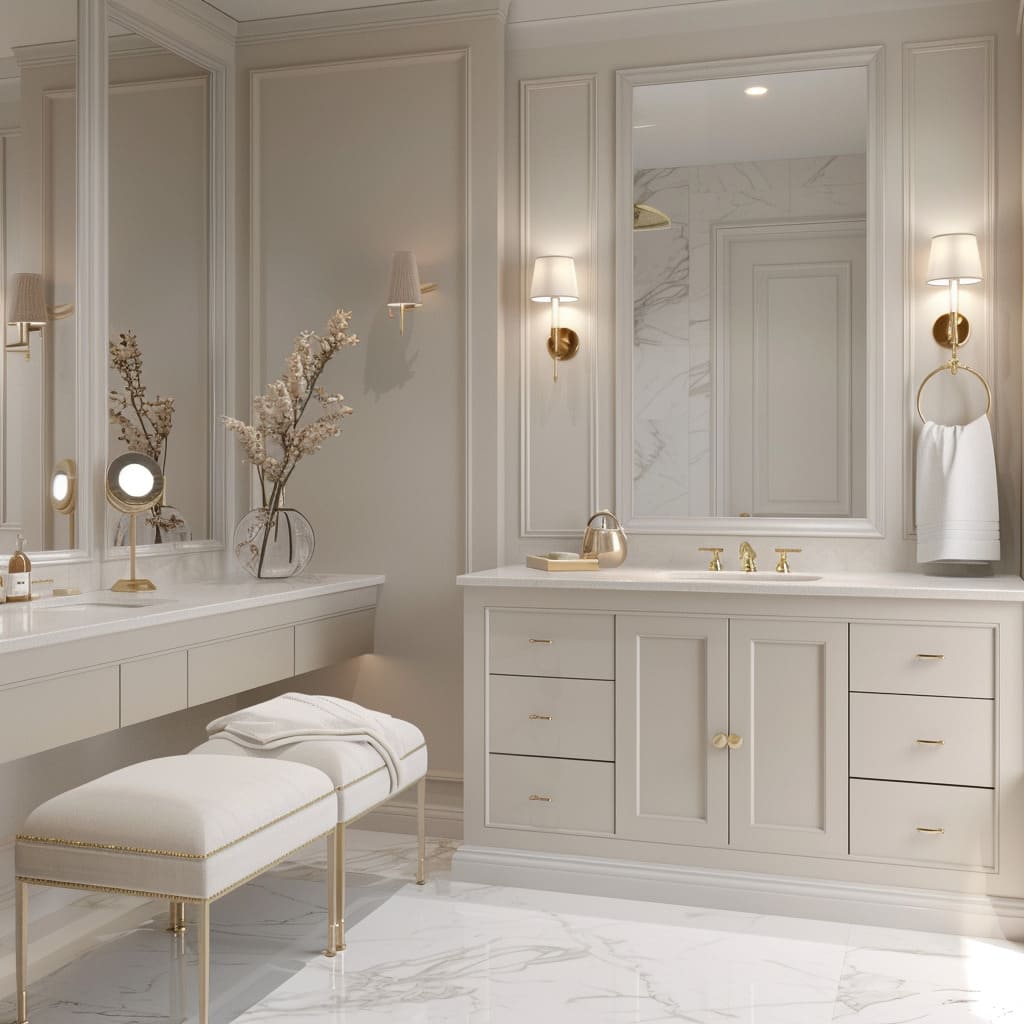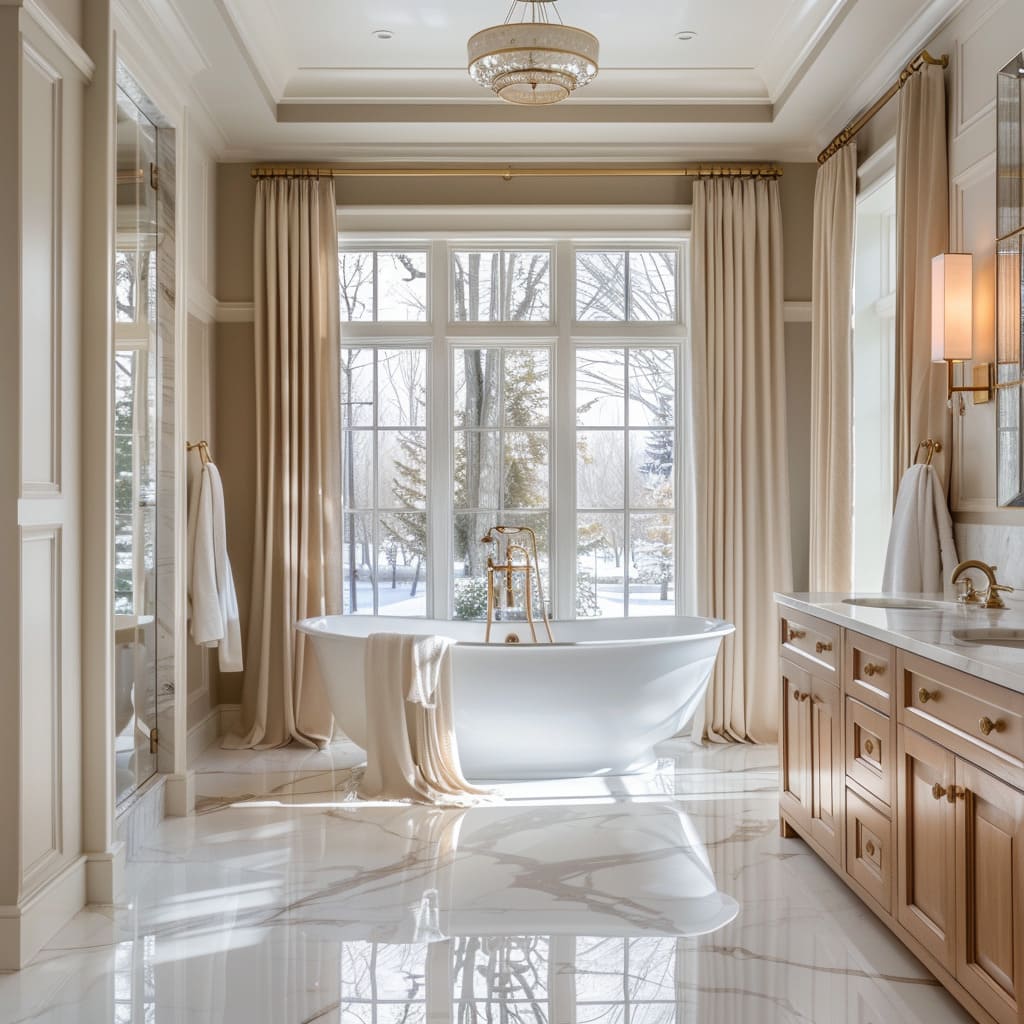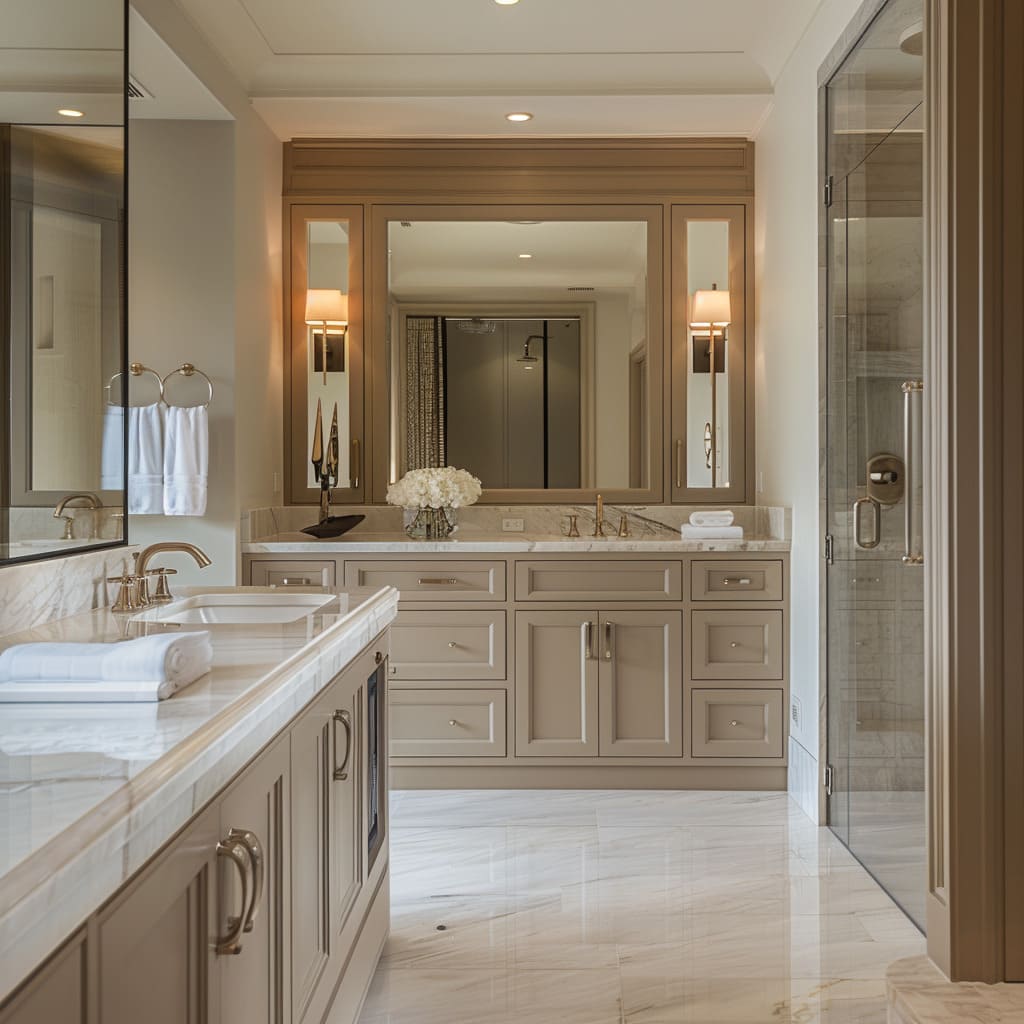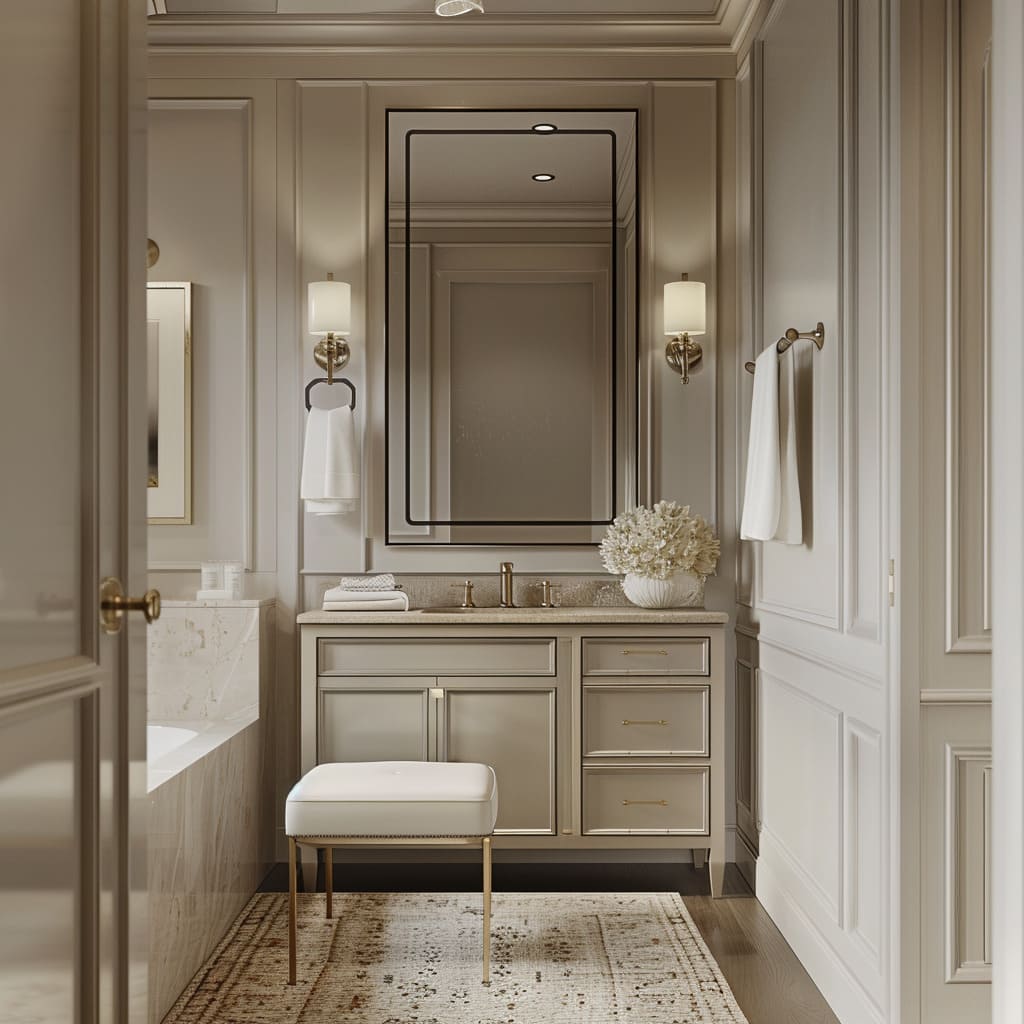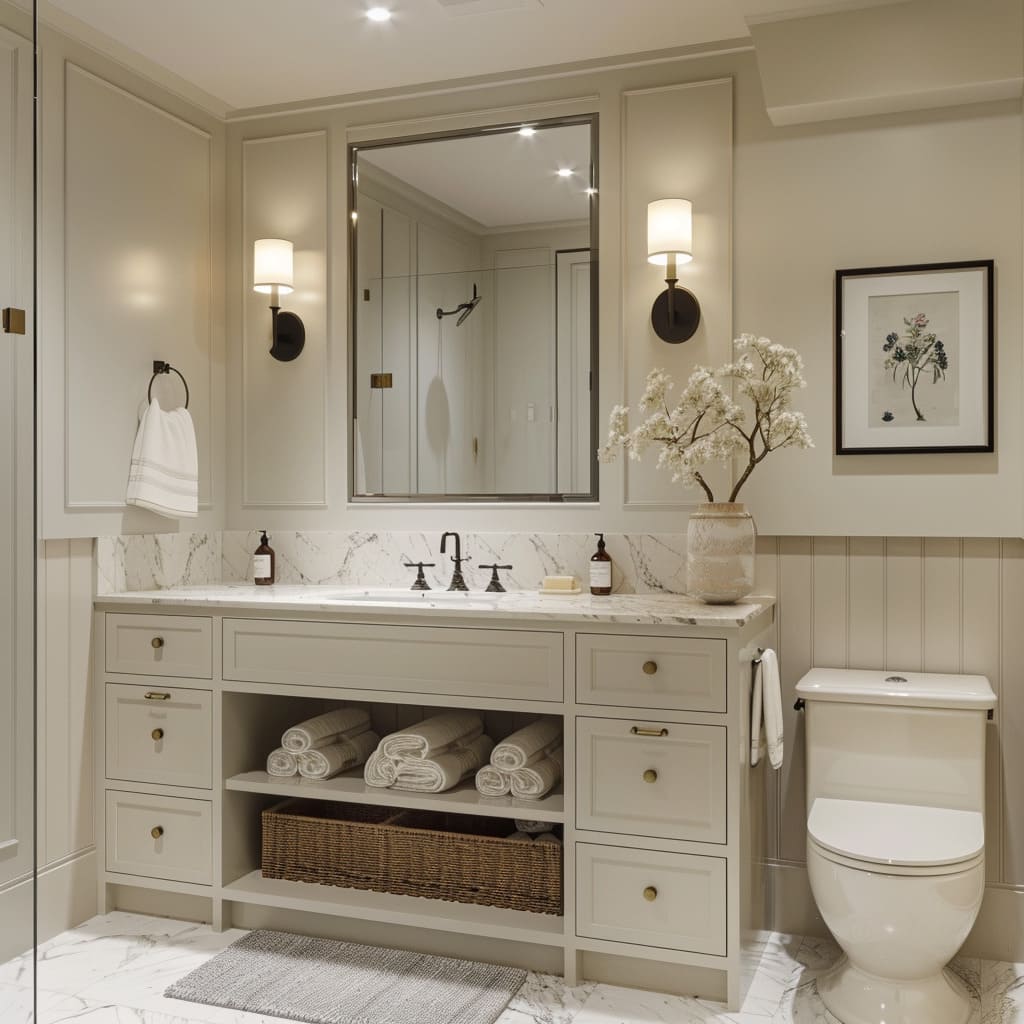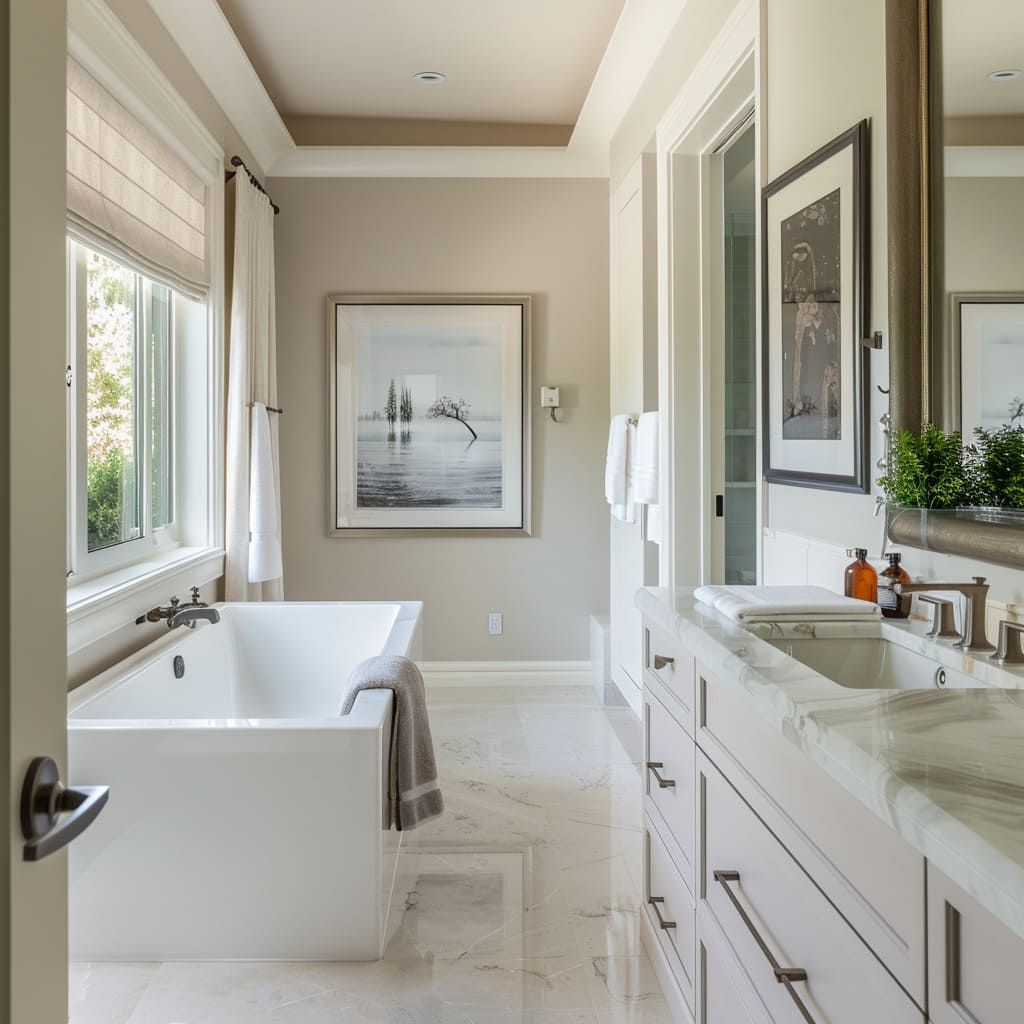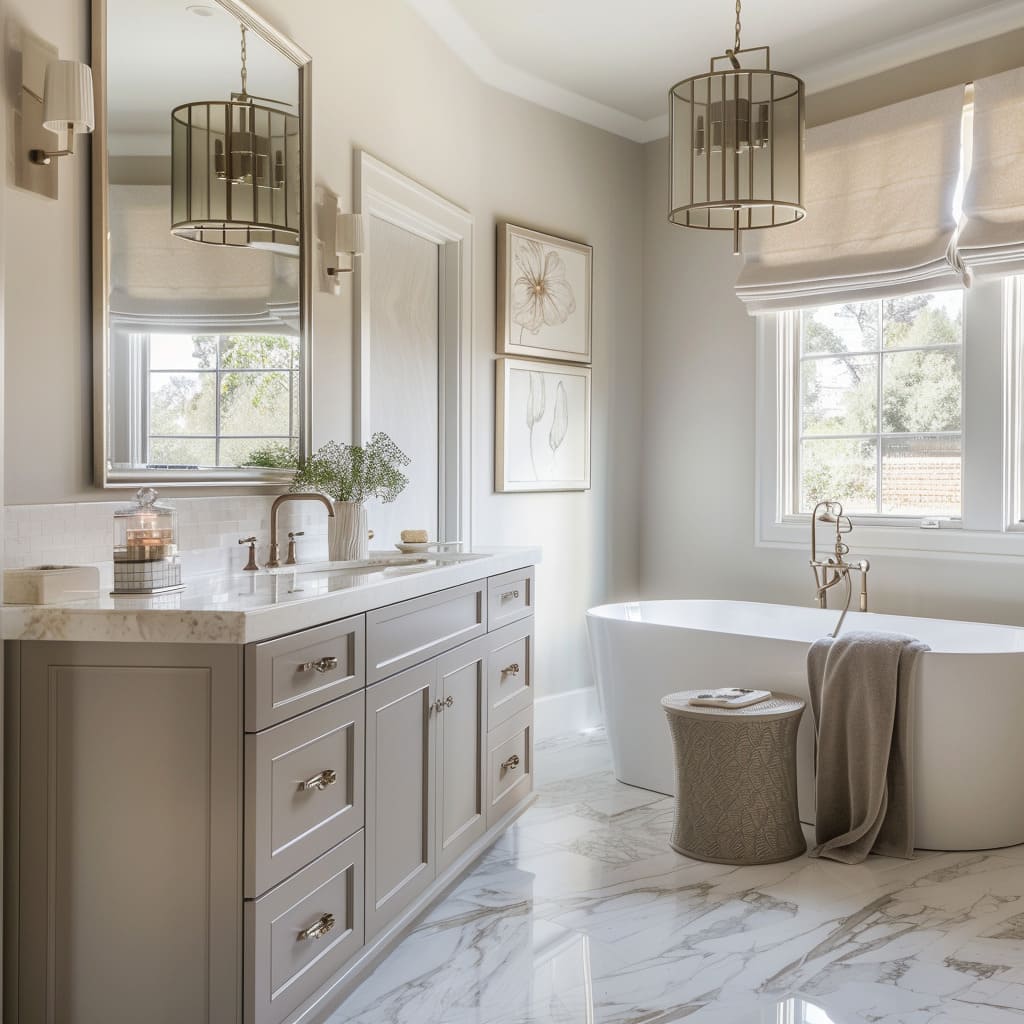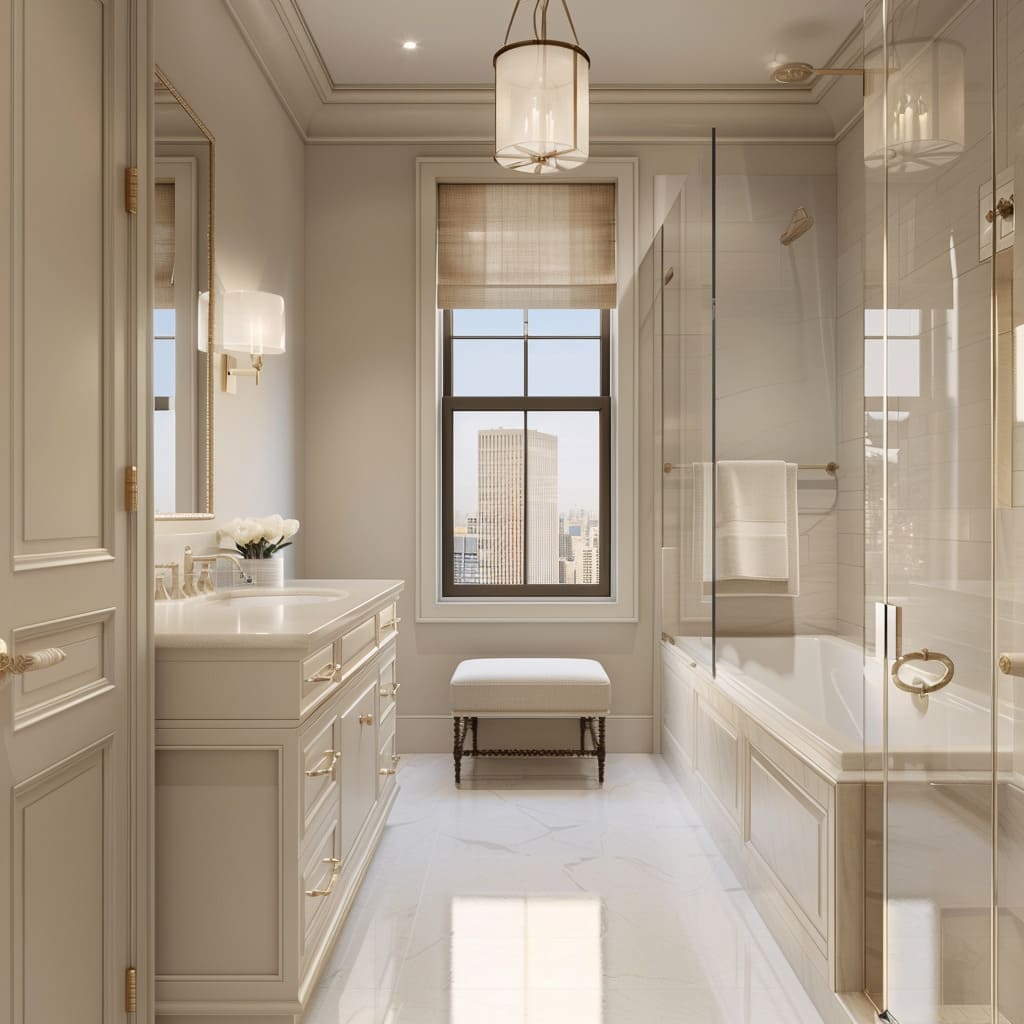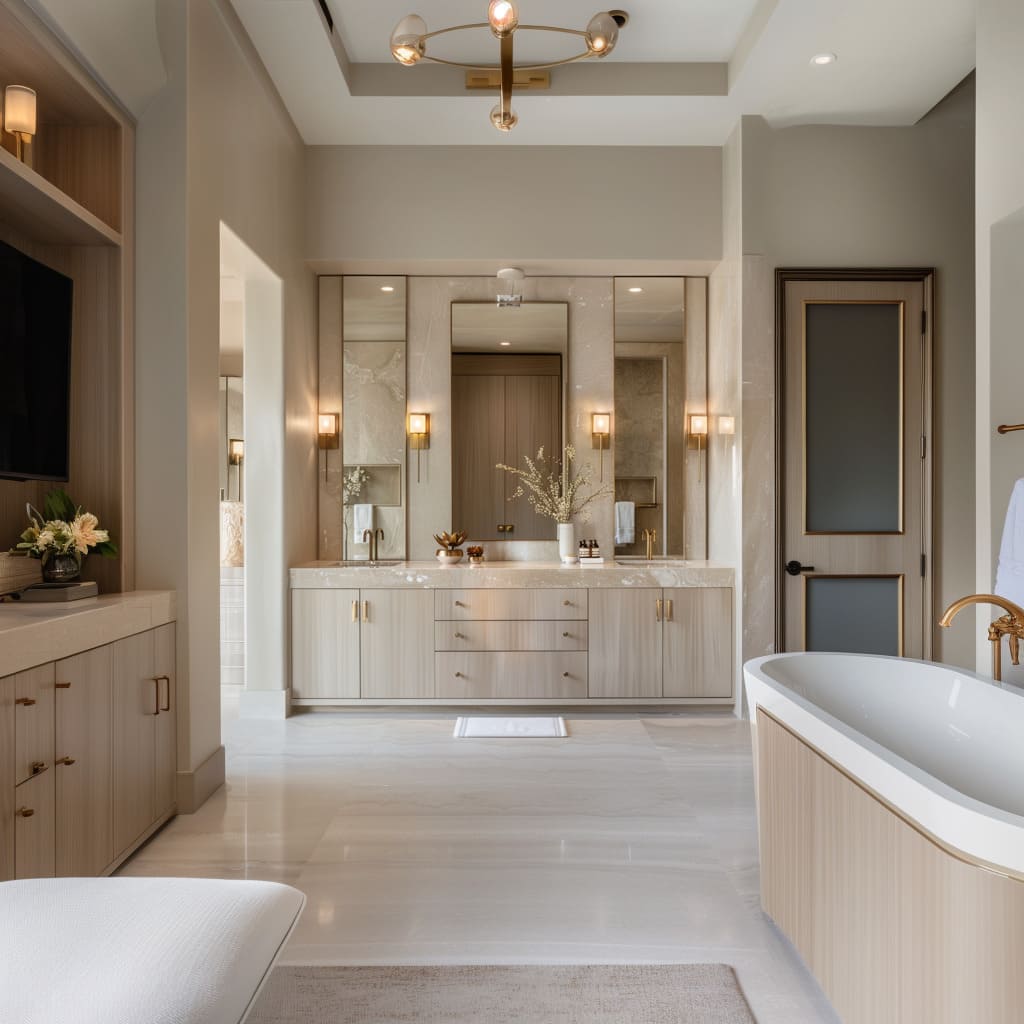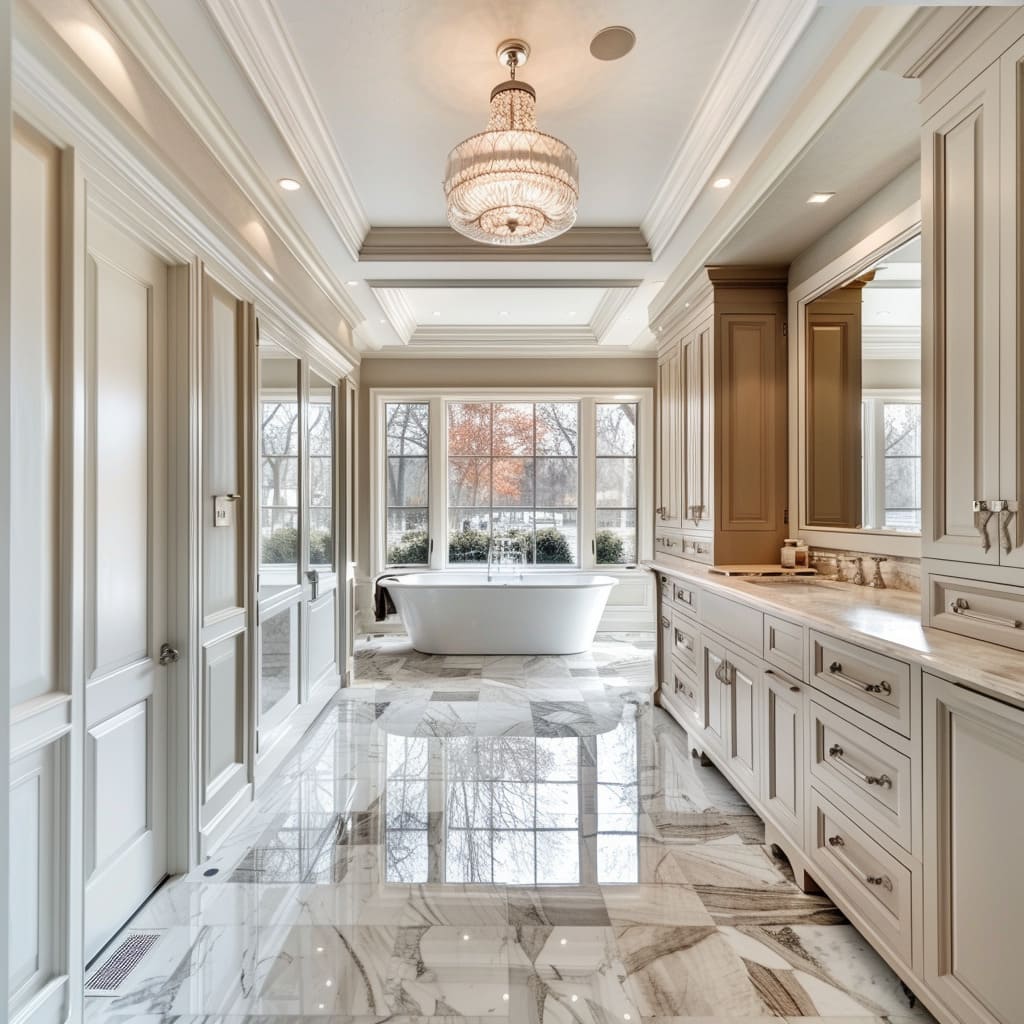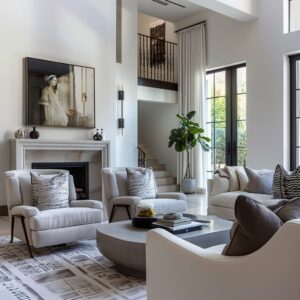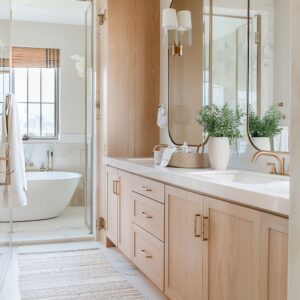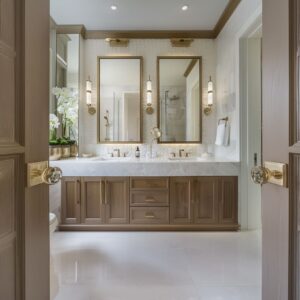Creating an interior that marries beauty with practicality is the cornerstone of contemporary transitional bathroom design. This style is celebrated for its ability to fuse the comforting familiarity of traditional aesthetics with the crisp efficiency of modern design, culminating in spaces that are both elegant and eminently usable.
This article aims to guide you through the nuances of achieving such a balance, outlining the key elements that contribute to a bathroom that is not just a visual delight but also a bastion of functionality.
Finishes and Fixtures: The Subtle Shine
In transitional bathroom design, finishes and fixtures serve as the unspoken heroes that bring an understated elegance to the space. This section delves into the sophisticated selection of finishes—from the soft luster of brushed nickel fixtures to the strategic use of mirrors and glass—that coalesce to create a unified and inviting environment.
Brushed or Satin Nickel Fixtures
This finish on faucets and handles offers a soft luster without the high shine of chrome or the warm tones of brass. The choice of brushed or satin nickel brings a versatile appeal, adapting to various design influences without overpowering other elements.
These fixtures stand as a testament to understated aesthetics, where their subdued sheen brings a calming presence to the environment. The gentle reflection of light they provide enhances the ambiance with a discreet charm that complements the room’s tone.
Glass Shower Enclosures
The use of glass promotes visual continuity and contributes to a feeling of expansiveness. Glass shower enclosures are pivotal in creating an illusion of more space, making the bathroom appear larger and more open.
The transparent barriers allow for an uninterrupted view, showcasing the quality tile work and other design features within the shower area. They embody both function and grace, serving as a canvas that doesn’t detract from the overall design narrative.
What’s Your Budget Good For? Get Instant Results
Curious about what your budget can achieve? Enter your details and get an instant look at your options!
Enter values to determine renovation level
Freestanding Bathtubs
These act as a focal point in the room and add a touch of modernity. The freestanding bathtub not only offers a place of relaxation but also serves as a striking design statement.
Its placement in the room is strategic, often allowing for an opulent feel within the space. These bathtubs provide a sculptural quality, drawing the eye and serving as a central feature that ties together the design elements around it.
Dual Vanities
Offering convenience and a symmetrical design element, dual vanities are a blend of form and function. They provide personal space for individuals sharing the bathroom, while also maintaining aesthetic symmetry.
Often designed with ample countertop space, these vanities ensure that daily routines are conducted with ease, and their thoughtful design complements the bathroom’s cohesive feel.
Which Vanity Cabinet Suits You Best?
Choose between a luxurious option with elegant finishes or one with a comfortable chair for added convenience!
Consistency in Finishes
Keeping hardware and fixtures within the same finish family to create a cohesive look is a subtle yet powerful design strategy. This approach streamlines the design, creating a unified theme that quietly commands attention without the need for ornate detailing.
It speaks to a design sensibility that values a seamless transition between elements, ensuring each feature is part of a larger, harmonious picture.
Streamlined Faucet Designs
Faucets in these bathrooms tend to have a streamlined look with moderate ornamentation, embodying the transitional space between contemporary minimalism and traditional detail. They exemplify how functional items can also serve as pieces of understated beauty, contributing to the room’s sophistication without clamoring for attention.
Accent Tiles
These may be used sparingly to add interest or a dash of color without overwhelming the space. Accent tiles break the monotony with texture or color, yet their application is restrained to avoid visual clutter.
They serve as thoughtful interjections in the design, allowing the eye to pause and appreciate the finer details embedded within the overall scheme.
Minimal but Impactful Hardware
Cabinet handles and knobs are chosen for their ability to complement the overall design subtly. This hardware is the final touch in the room, akin to the perfect piece of jewelry that completes an outfit.
They offer a tactile experience that is both practical and visually satisfying, enhancing the user interaction with the space on a daily basis.
When planning a contemporary transitional bathroom renovation, understanding the potential costs is crucial. To help with budgeting, check out this bathroom remodel budget calculator. It provides a rough estimate based on the room size and your needs.
Space and Structure: The Blueprint of Tranquility
How a bathroom is laid out and what structural elements are included can dramatically influence its ambiance. Here we examine the efficient use of space, the comfort provided by seating, and the visual interest added through cabinetry and millwork.
Each aspect is meticulously considered to ensure a balance between aesthetics and functionality.
Sophisticated Cabinetry
The cabinets often exhibit refined craftsmanship with a blend of traditional and contemporary styles. These storage solutions are not only practical but are crafted to appear as intrinsic elements of the room’s design, often featuring subtle details that resonate with both modern sensibilities and time-honored techniques.
The hardware chosen usually complements the cabinets’ style, contributing to their sophistication without overwhelming their design.
Custom Millwork
This includes wainscoting, crown molding, and baseboards that are often understated yet present. This level of customization introduces a layer of complexity and personalization to the space.
Whether painted to blend seamlessly with the walls or stained to highlight the natural beauty of the wood, this millwork is integral in achieving a finished look that speaks to quality and attention to detail.
Moderate Use of Molding and Trims
These elements are present but not as elaborate or ornate as in traditional designs. They strike a balance, creating an inviting ambiance that complements the room’s more modern fixtures and amenities.
The moderate use of these details ensures that the space feels neither stark nor overwrought, maintaining an air of sophistication that is both approachable and timeless.
Efficient Use of Space
Layouts are designed for movement and usability without unnecessary elements. The design philosophy here is about creating a fluid environment where each item and structure is there for a reason.
This efficiency encourages a calming flow within the space, which aids in the creation of a serene and uncluttered atmosphere.
Comfort in Seating Seating
is not just practical but also designed for comfort, often upholstered in a fabric that complements the room’s palette. This thoughtful addition turns a purely functional space into one that invites relaxation.
Whether it’s a bench covered in plush fabric or a subtly designed ottoman, seating is incorporated to enhance the user’s experience.
Optimized Storage Solutions
Storage is integrated in a way that maintains the sleek look of the space. By maximizing the utility of each drawer and cabinet, these designs allow for a tidy environment free of clutter.
The clever use of storage is also an exercise in visual calm, as the necessary everyday items are kept out of sight, contributing to the room’s orderly feel.
Accentuation of Vertical Lines
This can be seen in the cabinetry or the tile work, sometimes drawing the eye upward. It creates a sense of height and grandeur, giving the space a more open and airy feel.
These vertical lines can serve to elongate the space, making it seem larger and more luxurious.
Integration of Traditional Motifs
This might include a traditional tile pattern or cabinet design updated with contemporary lines. This subtle nod to the past honors the roots of design while situating it firmly in the present.
By blending these motifs into the larger modern context of the room, the space becomes a bridge between the comfort of tradition and the freshness of modern design.
Surfaces and Textiles: The Tapestry of Touch
The tactile experience in a transitional bathroom is just as important as the visual one. We explore the use of various surfaces, from the cool smoothness of ceramic tiles to the soft embrace of plush towels, highlighting how each contributes to the overall sensory experience.
Ceramic and Porcelain Tiles
These materials are prevalent for their practicality and adaptability to various design aesthetics. Their surfaces, cool and smooth underfoot, bring a sense of clean sophistication to the space.
Durability meets style in these choices, as they stand up to the humidity and wear of bathroom environments while offering a canvas for design expression. Often, these tiles are laid in patterns that subtly draw attention, such as herringbone or basket-weave, contributing to the room’s overall dynamic without overpowering it.
Subdued Wall Treatments
Walls are often finished in a subtle way, with either paint or a non-dominant wallpaper design. The choices in color and texture serve to create a backdrop that complements rather than competes with the room’s fixtures and furniture.
These treatments act as a foundation for the design, setting a tone that is both understated and inviting. The continuity of wall treatments helps to unify the space, providing a serene backdrop that allows other elements to shine.
Understated Window Treatments
They often allow for natural light while providing privacy and a soft decorative touch. Whether employing translucent materials that filter light or using designs that frame the window without hiding it, these treatments contribute to a room that feels both bright and sheltered.
In some designs, the window treatments may feature subtle patterns or textures that echo other elements in the space, tying the room together in a quiet echo of the overall design theme.
Balanced Mix of Textiles
Towels and bath mats are chosen to provide comfort while fitting into the color scheme and design. This careful selection ensures that these everyday items contribute to the design as much as they offer practical utility.
The textiles might feature a ribbed texture for a tactile experience or be made of lush fabrics that speak to the indulgence of the space. They are not mere afterthoughts but integral components that enhance the room’s aesthetic cohesion.
Tactile Surface Finishes
This includes countertops and tiles that are pleasant to touch and add to the sensory experience of the space. Beyond visual appeal, these surfaces invite interaction.
The choice of materials here—from polished marble to honed granite—demonstrates an understanding of how daily contact with the environment affects our appreciation of the space.
Contrast in Material Textures
Combining different material textures without them competing for attention creates a layered effect that is visually and physically engaging. The juxtaposition of a smooth countertop against a textured tile, for instance, can accentuate both materials, offering a complex experience that is subtly orchestrated.
This interplay of textures adds depth and interest to the room, enhancing the design without causing visual fragmentation.
Subtle Use of Color
While the palette is often muted, there may be understated pops of color through accessories or art. These elements of color act as delicate highlights within the space, offering a glimpse of personality and vibrance.
In a room where the tones are carefully restrained, these pops can be focal points that guide the gaze or serve as an unexpected delight. This approach to color maintains a serene atmosphere while allowing for personal expression and character.
Lighting and Mirrors: Reflective Illumination
Lighting and mirrors play a pivotal role in the design, impacting not just functionality but also the mood of the space. In this section, we discuss the careful placement of task lighting and sconces, as well as how mirrors are selected and positioned to enhance both light and the feeling of openness.
Selective Use of Mirrors
Besides their functional aspect, mirrors are used to create a sense of depth and to accentuate natural lighting. Mirrors are positioned not just for utility but also to capture and reflect the light, enhancing the brightness and airy quality of the room.
They can often be found above vanities or across from windows, doubling the visual space and bringing in the warmth of the light, thereby making the area feel more open and welcoming. The frames around these mirrors are chosen with care, sometimes adding a contrasting note or harmonizing with the existing fixtures and finishes.
Strategically Placed Sconces
Wall sconces are placed to complement the overhead lighting and add to the room’s ambiance. These light fixtures are selected for both their luminance and their design, serving as an ornamental yet functional element.
They cast a glow that can warm the space and provide lighting that reduces shadows, which is particularly important near mirrors where clarity is paramount. The design of the sconces often mirrors the aesthetics of the space, with finishes that match other fixtures and forms that align with the room’s style.
Task Lighting
Focused lighting near vanities or over tubs is designed for practicality and ambiance. This lighting is essential for tasks that require precision, such as applying makeup or shaving, but it also serves to create a zone of warmth.
These lights are often on adjustable dimmers, allowing for the intensity of the light to be controlled to suit the mood or the needs of the moment. The fixtures used for task lighting are typically cohesive with the room’s overall design, providing a seamless integration of function and style.
Each of these lighting elements works in concert to ensure that the bathroom is not only well-lit but also that it resonates with a feeling of restfulness and calm. The interplay between light and reflective surfaces is carefully calibrated to ensure that the space feels balanced and harmonious at any time of day.
Design Philosophy: The Harmony of Elements
The transitional bathroom style is more than just a sum of its parts; it’s a philosophy that prioritizes visual comfort, a moderated color saturation, and a subtle yet distinct use of color. This final section contemplates the overarching approach that defines the transitional aesthetic, where each design choice is an intentional stride towards creating a serene retreat.
Moderated Color Saturation
These designs use colors that are saturated enough to create warmth yet muted enough to maintain a serene ambiance. This thoughtful approach to color selection contributes to a space that feels grounded and centered.
The hues chosen often work to complement natural materials and textures found within the space, fostering a cohesive and inviting environment. The colors are picked not only for their beauty but for their psychological effects, supporting a tranquil and calming atmosphere that enhances the overall experience of the space.
Utilitarian Object Display
Items that are displayed tend to have both a functional and an aesthetic purpose. These objects, ranging from artfully arranged toiletries to tastefully selected containers, are there to enhance the user’s interaction with the space.
They are strategically positioned to be easily accessible, yet do not intrude into the space unnecessarily. Each item on display is chosen for its quality and its ability to resonate with the room’s overall theme, contributing to the sense of curated elegance.
Curated Visual Access
Views, where available, are framed and accentuated through the design. Whether it’s a vista of the outdoors or a view into another beautifully designed area of the home, these views are considered an integral part of the bathroom’s design.
Windows or openings are treated as living artworks, with treatments that enhance rather than block the outside world, seamlessly connecting the interior with the exterior.
Visual Comfort
The overall visual effect is designed to be calming and restful, a retreat from the outside world. Soft, diffused lighting, combined with the color palette and material choices, creates a sanctuary-like environment.
The design is intentional in avoiding visual clutter or starkness, opting instead for a balanced, peaceful space that encourages relaxation and rejuvenation. It’s a space where every element is in harmony, promoting a sense of well-being and ease.
This philosophy of design extends beyond mere aesthetics, engaging the senses and catering to the well-being of its inhabitants. The space is an oasis, constructed with the intent to soothe, to please, and to function with effortless grace.
Every element within the design is an invitation to step back, to breathe, and to enjoy the moment.
In sum, the art of crafting a bathroom that stands at the crossroads of contemporary flair and transitional timelessness lies in the attention to detail—a symphony of well-chosen finishes, harmonious structures, tactile surfaces, strategic lighting, and a design philosophy rooted in visual and practical harmony.
It is about creating a space that caters to the demands of daily life while providing a peaceful escape. This guide serves as your compass in navigating the design process, ensuring that every choice you make contributes to a bathroom that is not just a room but a personal sanctuary where design meets purpose.

